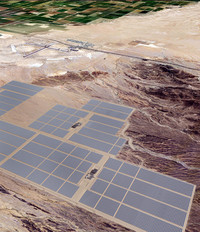Photos of Construction at Blythe Solar Project
December 4, 2015 - Blythe CA - The following photos are of the construction of the Blythe Solar Power Project, covering 4,000 acres of public lands on the Palo Verde Mesa just west of Blythe, California. The site was home to several archeology sites, Pleistocene desert pavements with old, rounded river cobbles, old growth desert ironwood trees and other microphyll habitats. This is all being converted to a large photovoltaic facility. The developers are using newer mitigation techniques such as vegetation mowing instead of vegetation scraping and "paddle scrapers" to minimize impacts to desert pavement. But as you can see, it is impossible to develop 4,000 acres of the California Desert without changing it for the worse. The photos come from the construction compliance reports that the developers are required to submit to the California Energy Commission during construction. The reports can be viewed here:
https://efiling.energy.ca.gov/Lists/DocketLog.aspx?docketnumber=09-AFC-06C
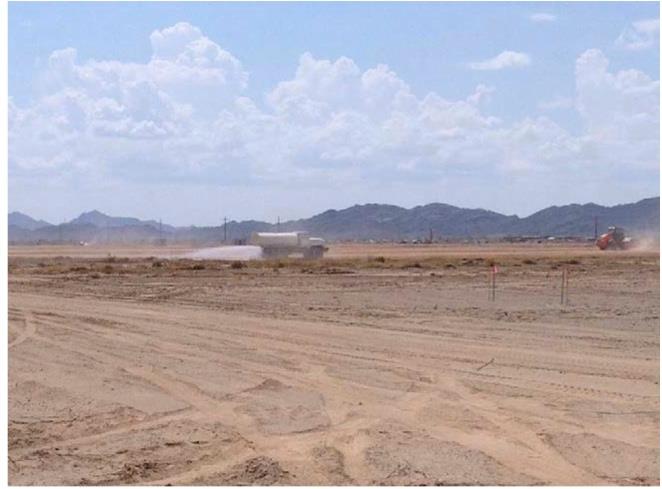
^Colorado Desert habitat being removed for solar panels. Water trucks out there all the time to control dust.
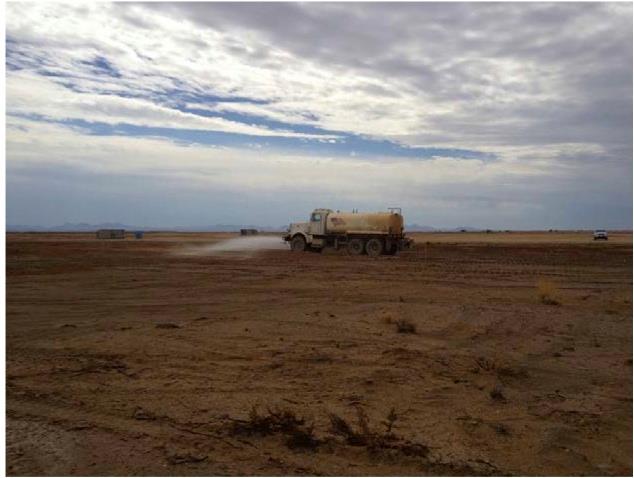
^Wholesale desert removal and water waste for dust mitigation.
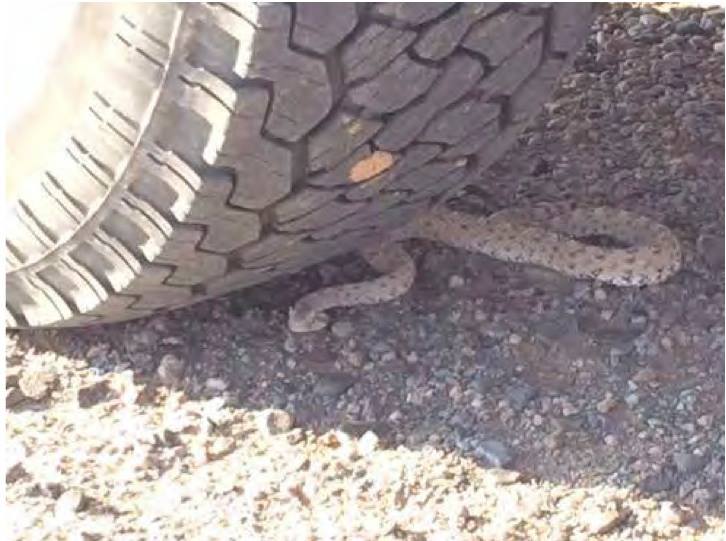
^Sidewinder under shade of truck tire. They moved this one, but imagine the millions of living organisms that are being killed for this huge project.

^How desert habitat is destroyed for big solar energy.
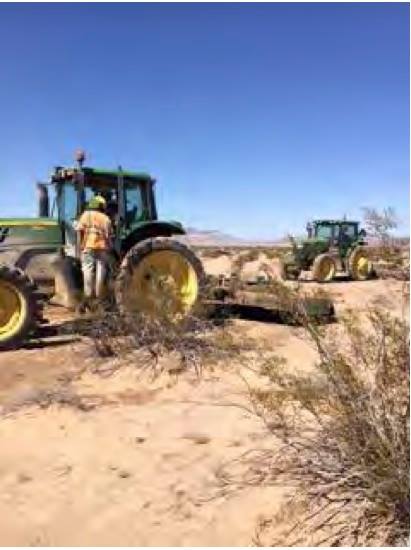
^The desert right before scraping with a biologist monitor.
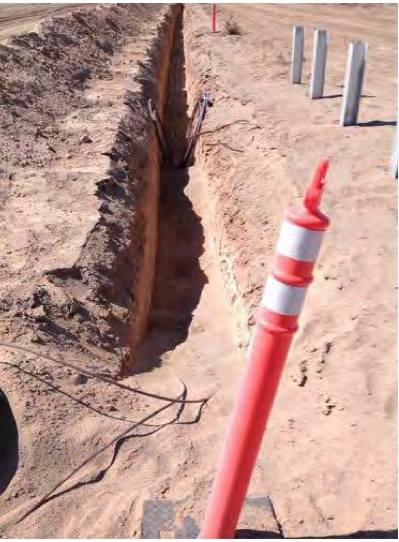
^Large electrical trenches are a death trap for small wildlife.
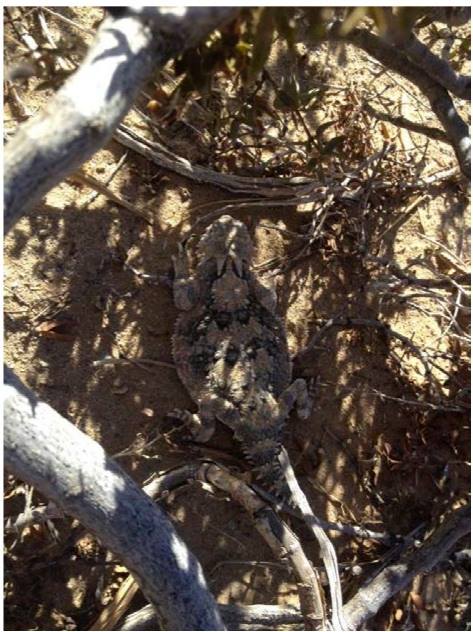
^Desert horned lizard found in trench. This one was removed. How many are missed?
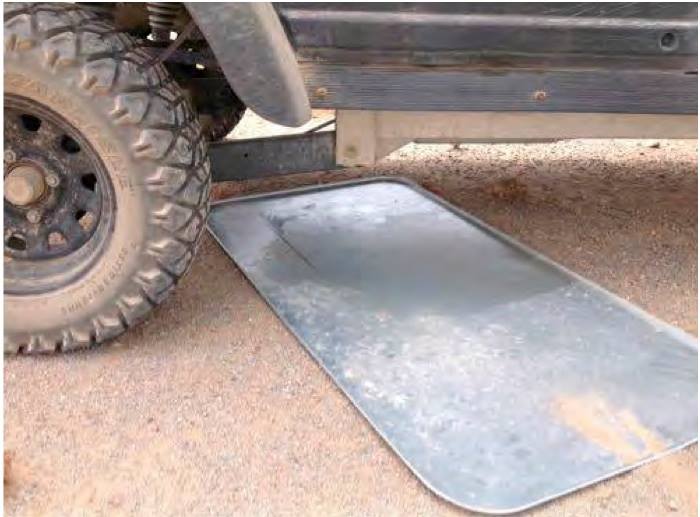
^Large construction equipment leaks all of the time. The plate is there to catch hazardous materials.
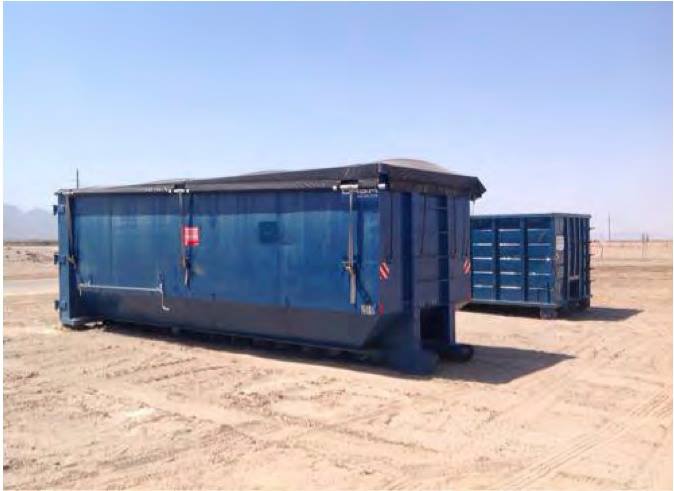
^All trash is placed in containers so ravens are not attracted. That was all Colorado Desert habitat.
Limited Construction to Begin
January 22, 2015 - The Blythe Solar Power Project has been given the go-ahead to start limited construction activities while the California Energy Commission staff is in the process of completing its review, provided the Bureau of Land Management has issued their notice to proceed.
The following activities may begin January 16, 2015, before the nesting bird season:
Mowing and vegetation removal and cacti salvage; installing permanent fencing around Units 1 and 2, with tortoise fencing attached to the bottom of the permanent fences (tortoise fencing around Unit 1 has already been installed with CEC/BLM permission but will be replaced); drilling a second well in Unit 1 including installing a well pad; grading of up to 10 acres for trailers and parking and no more than an additional 10 acres for the substation and Operations & Maintenance areaarea; and setting 10 gen-tie poles and line.
Activities are not supposed to impact any known cultural resources for which treatment has not yet been approved. We will have to wait and see how the numerous geoglyphs monitored by the tribes and La Cuna de Aztlan Sacred Site Protection Circle.
Colorado River Indian Tribes Sue Over Blythe Solar Project
December 11, 2014 - Blythe CA - The Colorado River Indian Tribes (CRIT) is challenging the Department of Interior and Bureau of Land Management in court over the Modified Blythe Solar Project owned by NextEra and under construction by First Solar on the Palo Verde Mesa next to the Colorado River.
The filing says "The Project site is located within the ancestral homelands of the members of
the Colorado River Indian Tribes ("CRIT" or "Tribes"), whose reservation begins just a few miles northeast of the site. The religion and culture of CRIT's members are strongly connected to the physical environment of the area, including the ancient trails, petroglyphs, grindstones, hammerstones, and other cultural resources known to exist there. The removal or destruction of these artifacts and the development of the Project as planned will cause CRIT, its government, and its members irreparable harm.
"As set forth below, BLM's approval of the Project violated the National Historic Preservation Act ("NHPA"), the National Environmental Policy Act ("NEPA"), and the Federal Lands Policy and Management Act ("FLPMA"). BLM conducted no government-to-government consultation with CRIT prior to approval of the Project. It then allowed the project developer to begin ground-disturbing activities before any cultural resource monitoring or treatment plans were in place. The Environmental Impact Statement ("EIS") prepared for the Project failed to take the requisite "hard look" at its impacts. And the Project itself is plainly inconsistent with the land use designations
adopted by the United States under FLPMA to protect the fragile desert ecosystem and cultural resources found at the Project site."
CRIT is seeking an injunction. See the >>court document.
Comment Deadline and Public Meetings
February 14, 2014 - Written comments will be accepted through March 24, 2014.
http://www.blm.gov/ca/st/en/fo/palmsprings/Solar_Projects/Blythe_Solar_Power_Project.html
A public meeting will be held at the Blythe City Hall on March 5, 2014, from 5 p.m. to 8 p.m.
For more information, contact the Bureau of Land Management Palm Springs Field Office at (760) 833-7100 or email CAPSSolarBlythe@blm.gov
Blythe Solar Project Given Final Approval by Energy Commission
Sacramento - The California Energy Commission on January 15 approved an amendment to
convert the 485-megawatt Blythe Solar Power Project from solar parabolic-trough to a solar photovoltaic plant.
By a 5-0 vote, the Energy Commission adopted the presiding member's proposed
decision (PMPD) allowing NextEra Blythe Solar Energy Center, LLC, to switch technologies.
"The project will spur California's transition to renewable energy and help advance its aggressive climate change goals," said Commissioner Karen Douglas who is the presiding member of the committee reviewing the Blythe Solar Power Project Amendment.
In its previous PMPD released December 13, 2013, the Committee said the project would have environmental impacts that are cumulatively significant when considered along with the impacts of other projects in the region. The cumulative impacts that cannot be mitigated to less than significant levels are impacts to biological resources, cultural resources, land use, and visual resources.
But the committee then found that the project benefits such as the "contribution to meeting California's Renewables Portfolio Standard, reducing greenhouse gas emissions, creating nearly 500 peak construction jobs, and boosting the economy" justify an override of those impacts. Basin & Range Watch disagreed.
Construction on the project is expected to last 48 months. The estimated capital construction
cost is $1.13 billion, according to the project owner. The Blythe Amendment Final Decision can be found here:
https://efiling.energy.ca.gov/Lists/DocketLog.aspx?docketnumber=09-AFC-06C
California Energy Commission Recommends License for Blythe Solar Project
December 20, 2013 - A committee inlcuding two commissioners met on December 13 to recommend approval of the Blythe Solar Power Project. Part of the decision reads:
"...the committee finds that the project, as mitigated, may have environmental impacts that are cumulatively significant when considered along with the impacts of other projects in the region. The cumulative impacts that cannot be mitigated to less than significant levels are to biological resources, cultural resources, land use, and visual resources. The committee finds that the project benefits—including its contribution to meeting California’s Renewables Portfolio Standard, reducing greenhouse gas emissions, creating an estimated 499 peak construction jobs, and boosting the economy — justify an override of those impacts."
Blythe Solar Project Back
August 31, 2013 -Blythe, CA - The Blythe Solar Power Project is back from the dead. In 2010, it was going to be a massive 10 square mile solar thermal project. The Bureau of Land Management approved it and the Department of Energy gave them a 2 billion dollar loan of your tax dollars. Months later, the project proponent, Solar Millennium, went bankrupt. The project was later purchased by NextEra, a big fossil fuel developer. The technology was converted to photovoltaic panels. The project footprint is reduced, but will still cover 4,138 acres of Colorado Desert habitat on the Palo Verde Mesa in Riverside County. The area is rich in cultural sites that are sacred to local tribes. The site also contains large desert ironwood trees, many close to 1,000 years old. You only have 30 days to comment on this one.
In the Federal Register:
Notice of Intent To Prepare an Environmental Impact Statement for the Blythe Solar Power Project, Riverside County, CA
http://www.gpo.gov/fdsys/pkg/FR-2013-08-30/html/2013-21285.htm
The Blythe Solar Power Project was originally permitted and approved on October 22, 2010, as a 1,000 megawatt (MW) solar thermal generating plant located on 6,831 acres of BLM-administered public land in the Palm Springs Field Office (CACA-048811). The Project area is located 8 miles west of Blythe, California, and 3 miles north of Interstate 10 (I-10). The ROW grant was originally issued to Palo Verde Solar I, LLC, a wholly-owned subsidiary of Solar Millennium, which filed for Bankruptcy in April 2012.
In mid-October 2012, NextEra Blythe Solar Energy Center, LLC (NBSEC), purchased the un-built BSPP as part of the bankruptcy process. The BLM approved the assignment of the ROW grant from the Palo Verde Solar I, LLC, to NBSEC on August 22, 2012. NBSEC now proposes to modify the solar technology and reduce the size of the project within the previously approved BSPP footprint. The NBSEC is proposing to construct, operate, maintain, and decommission the BSPP using solar photovoltaic (PV) technology with a capacity of 485 MWs on 4,138 acres of BLM-administered public land, as opposed to the originally approved 1,000 MWs on 6,831 acres.
The NBSEC has submitted an amendment to the existing ROW grant (CACA 048811) to reduce the overall acreage of the project, change the authorized technology from concentrating solar trough to solar PV, adjust other aspects of the project layout related to the technology change, and reduce the BSPP's authorized capacity from 1,000 MW to 485 MW (the ``Modified Project''). In connection with its development of the Modified Project, NBSEC filed a partial relinquishment of the existing ROW grant with the BLM on March 7, 2013. The BLM has determined that the requested amendment for the Modified Project is not within the range of alternatives analyzed in the EIS prepared in connection with the original 2010 decision for the project; therefore, the BLM must undertake additional NEPA analysis to evaluate the proposed amendment. The purpose of the public scoping process is to determine relevant issues that will influence the scope of this environmental analysis, including alternatives, and to guide the process for developing the Draft EIS. The BLM has identified the following preliminary issues: Noise, visual resources, wildlife, vegetation, hydrology, air quality, and cumulative effects along with other areas with high potential for renewable energy development.
ADDRESSES: You may submit comments on issues and alternatives related to the BSPP EIS by any of the following methods: Web site: http://www.blm.gov/ca/st/en/fo/cdd.html. Email: fmcmenimen@blm.gov. Fax: 760-833-7199, Attn: Frank McMenimen. Mail: ATTN: Frank McMenimen, Project Manager, BLM Palm Springs Field Office, 1201 Bird Center Drive, Palm Springs, CA 92262-8001. Documents pertinent to this EIS may be examined at the BLM California Palm Springs Field Office.
La Cuna de Aztlán Sacred Sites Protection Circle Letter of Opposition to the Blythe and McCoy Solar Projects
August 20, 2013 -
Alfredo A. Figueroa Phone: (760) 922-6422 424 N. Carlton Ave E-mail: lacunadeaztlan@aol.com
Blythe, Ca 92225
Frank McMenimen, Project Manager
Bureau of Land Management
California Desert District
22835 Calle San Juan de los Lagos
Moreno Valley, CA 92553
RE: Comments of Opposition at the Cultural Resources Meeting for the Amended McCoy Solar Energy Project and the Blythe Solar Project held at Blythe City Hall in Blythe, California on July 23, 2013.
Dear Mr. McMenimen:
My name is Alfredo Acosta Figueroa and I am one of the Chemehuevi Tribal Monitors of the sacred sites. I am the Elder/Historian/Coordinator of La Cuna de Aztlán Sacred Sites Protection Circle and a member of Californians for Renewable Energy (CARE).
La Cuna de Aztlán Sacred Sites Protection Circle is comprised of 13 indigenous and culturally aware individuals including an anthropologist and archaeologist who mostly reside along the Colorado River from Needles down to Yuma and are dedicated to protecting these sacred sites.
We would like to bring attention to what we felt were grave violations of our Native American rights and public trust by the Bureau of Land Management.
Regarding BLM's meeting at Blythe City Hall on July 23, 2013 on the topic of Nextera Energy Resources proposed amended Blythe Solar Project and McCoy solar energy project, we did not receive any information via USPS, email or phone. We were notified of this meeting by chance when we were attending another meeting of the California Energy Commission concerning the amended Palen Project on July 22, 2013 in Palm Desert, California. If Mr. McMenimen had not asked me if I was attending the meeting the following day, I would have never known about the meeting. At that instance, I told Mr. McMenimen to please come and tell the group of Mojaves, Quechanes, and us that BLM was going to have a meeting the following day in Blythe. None of the group that was there had received any notice and Mr. McMenimen told us he had sent the notice by express mail. The notice of the meeting caught us all off guard. We were completely unaware of the situation prior to our conversation with Mr. McMenimen.
The following day, my brother and I went to the BLM meeting at Blythe City Hall. There were not any notices of the meeting placed outside or inside of City Hall nor was there an agenda for this BLM meeting. As far as we could tell, there was no one in attendance taking minutes nor was the meeting being recorded by BLM and there was just one handout which was from Nextera about the proposed modified Blythe Solar Power Project. In reality, we didn't know what the meeting was going to be about.
In attendance at the meeting were Mojave, Torres-Martinez, Quechanes, Colorado River Indian Tribes members, and us. The first topic of the evening was the Nextera Energy Resources proposed effort to continue with the Blythe Solar Millennium Project.
Matt Tennyson, an archaeologist from AECOM spoke of the reduction of the size of the original application from 9,000 acres down to 4,300 acres and that the original transmission line roadway that destroyed part of the eastside of the Kokopilli/Cicimitl twin group had been moved approximately 1 mile west to avoid the geoglyphs. During his report, he was constantly being questioned by the Quechan group pertaining to the threatened sacred sites and trails in the area which is where the north/south Quechan trail goes through that leads down from Spirit Mountain north of Laughlin, NV down to Pilot Knob west of Yuma, AZ.
When this topic was concluded, BLM introduced the topic of the McCoy solar project that is proposed just north of the Blythe solar project. Again, the tribes in attendance were caught completely off guard because we had never attended a BLM meeting pertaining two solar power sites in the same meeting. What we saw was that the BLM was trying to fast track the final approval of the proposed projects by the federal government.
During the hearing, Lori Cachora, cultural director of the Quechan, spoke at length that the government agencies are not enforcing the laws that the government has passed in support of the Native American sacred sites culture and tradition. He spoke that these sites are being destroyed just like in the Genesis solar power project totally disregarding the Native American cultural impact and that we didn't want to suffer another Genesis.
The Mojave representative made similar comments. Phil Smith of CRIT also spoke of the same with regards to destruction of the sacred sites.
I was the last speaker. I told those in attendance that the Blythe solar and McCoy solar projects were proposed at McCoy Wash Valley, the most sacred site of the world and it was the worst location for the solar company to place these massive solar projects. It is where the spirit of El Tosco descends down from Tamoanchan and is the center of the Creation story. The Blythe Solar Millenium Company damaged sacred sites located along the 5 mile long, 300 foot wide transmission line roadway. At the end of the roadway is a one square mile leveled area that destroyed even more geoglyphs within the site. This company filed bankruptcy after the damage was done.
During my talk, I showed some of the geoglyphs and other large quartz stone outline of a man with a large round head that represents Quetzalcoatl leaving. This large surface quartz image is directly one mile west of the Kokopilli/Cictmitl group and is in line with the McCoy Mountain Pass opening. The archaeologist questioned me because he had never seen it. I related to him that regardless of where you move sites, it will affect other sacred sites and that is what is going to happen here if that transmission line is moved west.
We are sending you factual information by La Cuna de Aztlán Sacred Sites Protection Circle to support why we are in opposition of Nextera Energy Resources proposed Blythe Solar Project and McCoy Solar Energy Project.
In 2008, La Cuna de Aztlán Sacred Sites Protection Circle entered into a Memorandum of Understanding (MOU) with the Bureau of Land Management, Yuma office to be guardians of the sacred sites. The MOU specifies the formation of partnership of Bureau of Land Management, Southern Low Desert Resource Conservation and Development, La Cuna de Aztlán Sacred Sites Protection Circle and Blythe Chamber of Commerce and Tourist Information Center for the protection of cultural resources including the world famous Blythe Giant Intaglios, as well as over 300 geoglyphs (intaglio), thousands of petroglyphs, hundreds of pictographs, surrounding mountain images and several hundred sacred sites that are located along the Colorado River extending from Needles, California down to Yuma, Arizona.
For the past 58 years, we have been studying the place of origin of the Azteca/Mexica, which is Tamoanchan/Aztlán/Chicomoztoc/Huehueltlapallan in the surrounding Palo Verde/Parker Valleys. The following is a brief history of where these sacred sites are located and what they mean to the creation story of the local indigenous tribes and Azteca/Mexica history.
The majority of these Sacred Sites and pictures relate to the surrounding area of the I-10 corridor. The I-10 Highway in Eastern Riverside County parallels some of the most sacred trails that connect many of the sacred sites that are located within the area. That is where the Cocomaricopa trail goes east/west and joins together with the Quechan north/south trail at the south end of the Blythe solar power project. These trails lead from the Blythe Giant Intaglios by the Colorado River, Mule Mountains to Eagle Mountain range (at the Joshua Tree National Park) and from the Creator's Throne on Black Rock Peak (10 miles west of Blythe, CA) that leads to Corn Springs (Tulla ) in the Chuckawalla Mountains.
The lower Colorado River Basin Valleys have been the home of many different indigenous linguistic families which at one time or another left and returned to the area. They went on their journey to the four directions. Their migration is symbolized by the Nahui-Ollin meaning four directions in the Nahuatl language. Some of the nations settled permanently in the area and others such as the Athapaskans left the Colorado River. Some went north to Alaska before the last Ice Age according to Chief Gary Harrison of the Athapaskan tribe. Other nations such as the Azteca and Olmeca went south thousands of years ago. The Chichimeca followed afterwards, then the Tolteca, Yaqui, and finally the Mexica in the 12th century, approximately 1160 AD. Some of the nations have gone full circle returning to the Colorado River (Krober 1976).
There are five native reservations in the Lower Colorado River Basin Valleys which include Fort Mojave near Needles, California to the North; Chemehuevi; Colorado River Indian Tribes; Quechan; and Cocopah, south of Yuma. Of these five, the Mojave and Chemehuevi are most prominent in the Palo Verde/Parker Valleys.
Each Native Tribe has a unique identity and interpretation of the creation given to them by the Creator. Yet, all the tribes relate to the same cosmic tradition of the Creator. The oral cosmic cultural traditional knowledge is still in tack despite the years of the policy of "Kill the Indian, Save the Man," by the United States Government.
Thanks to the Native Mexica cultural tradition, the Uto-Aztecan still has a few Pre-Hispanic codexes that relate to the Creation Story on the lower Colorado River Basin Valleys. We have been able to compare them with the surrounding mountains, geoglyphs, petroglyphs, pictographs, the cosmic events of equinoxes and solstices in the Palo Verde/Parker Valleys and the local indigenous oral history.
For the Mexica, there would not be any authentic history if it wasn't backed up by the cosmic archetype. The visible part and the invisible of reality correspond mutually. That's why we can prove what these sacred sites mean without a shadow of a doubt.
The majority of these sacred sites extend west to the San Jacinto Mountains; east to Tonopah/Aguila, Arizona; north to the Avi-Kwamé Spirit Mountain, northwest of Laughlin NV; and south to the Gulf of California.
The Aztec sunstone calendar is the monolith relic that has the most documented history of the world. The major glyphs on the Sunstone are geographically located in the surrounding mountains of the Palo Verde/Parker Valleys. The Five Suns depicted in the Aztec sunstone calendar all have a beginning and an ending and are inter-related with Tamoanchan (Granite Peak), approximately 45 miles northwest of Blythe. Granite Peak is where the cosmos meet Earth. When you see Granite Peak from West Blythe (Acacitli), it looks exactly like a pyramid that is between the Little Maria and Big Maria Mountains on the right and the McCoy Mountains on the left. This is where cosmos meet Earth. In the Nahuatl language, it is called Tamoanchan. "Ta" relates to Tata which means grandfather and it represents the cosmos. "Moan" means merging and "chan" relates to chante which means house. In other words, Tamoanchan relates to the spirit descending down to Mother Earth which is manifested in the geoglyphs that are in the McCoy wash where the Blythe Solar Millennium and McCoy Solar Power projects are proposed.
The following is an excerpt of the book, Tamoanchan/Tlalocan Places of Mist based on the codexes and written by Alfredo Lopez Austin that relates to Tamoanchan:
"The Earth and the Sky were created, from the body of Cipactli, and with them was also established, along with the great division of the feminine and the masculine of the cosmos, the four posts, represented by trees or gods, or men, were converted into the roads of the gods. They were the roads of the gods because through their hollow trunks flowed the opposite divine essence (man/sun and woman/earth) they flowed between the two halves of Cipactli."
Seeing the falling of the sky over the Earth, all four were ordered to make through its center of Earth, four roads to be able to enter and raise up the sky and to get help. Four men were created. One was called Cuauhtémoc; the other, Itzcoal; Izmalli; and the other, Tenexochilt. Cuauhtémoc is the southeast corner of the Nahui-Ollin for the four directions (swastika image). Cuauhtémoc's Nagualli( your animal spiritual representation) is the eagle during the descending Sun. The translation of Cuauhtli is Eagle and Temoc is descending. Cuauhtémoc means Descending Sun (Eagle) which is manifested by the sun descending on Eagle Mountain.
The Descending Sun when seen from the Ripley Intaglio during the Summer Solstice (June 21) sets on a large V that is on the southeast side of the Eagle Mountain range inside of Joshua Tree National Park. The V is the origin of Dragon Wash (the dragon represents Quetzalcoatl, the Plume Serpent). The Plume Serpent descends down from the V where the sun sets.
The four corners of the base of the sky falling are shown in the Borgia Codex Plate 72, and its Earth's cosmic duality geographical site is Granite Peak. This is where sky meets earth and gives the image of the X or hourglass appearance. The top V of the X represents the cosmos and the upside down V of the X represents Granite Peak and Mother Earth.
The emission control laws in California are currently being met and cities are now proposing to include rooftop solar panels in each new construction within the many cities. Finally, the Federal Reserve Chairman Ben Bernanke said on February 27, 2013 that he wants to end investor perceptions that the largest U.S. financial institutions will be given taxpayer bailouts to prevent a collapse. “We need to stop too-big-to-fail.”
Supporting our facts of opposition to the solar projects is California Energy Commission's Docket # 09-AFC-8 Cultural Resources report by Elizabeth A. Bagwell & Beverly E. Bastian dated 06/22/2010 supporting research stipulates that:
“Staff finds that the GSEP construction impacts, when combined with impacts from past, present, and reasonably foreseeable projects, contribute in a small but significant way to the cumulatively considerable adverse impacts for cultural resources at both local I-10 Corridor and regional levels. This analysis estimates that more than 800 sites within the I-10 Corridor, and 17,000 sites within the Southern California Desert Region, will potentially be destroyed. Mitigation can reduce the impact of this destruction, but not to a less-than-significant level.”
For these reasons, and the following Indigenous, State, Federal and United Nation laws we are opposing to the Amended McCoy Solar Energy Project and the Blythe Solar Project because of their gross violation to the following:
• Inter-Tribal Council of Arizona: Resolution 0212, opposing the Department of Interior Fast-Track Polices of Renewable Energy Projects on Ancestral Homelands, June 29, 2012. The Resolution specifies that whereas over 40 proposed solar and wind renewable energy projects are to be undertaken within a 50-mile radius of the Colorado River Indian Tribes Reservation which puts tens of thousands of acres of land within the ancestral territory homelands of CRIT as well as other Yuman tribes, at further risk of destruction.
• National Congress of American Indians: Resolution #LNK-12-036, opposing the Department of Interior Fast-Track Polices of Renewable Energy Projects on Ancestral Homelands, June 17, 2012.
• Colorado River Indian Tribes Resolution and Letter to President Barack Obama: opposing the construction of Solar Power Projects within 50-miles from the CRIT Reservation boundary of February 27, 2012.
• United Nations Declaration on the Right of Indigenous People Resolution of 2007: was adopted by the General Assembly during the 107th plenary meeting and was signed by President Barack Obama on December 15, 2010.
• Native American Sacred Places, March 6, 2003(S.B. 18)
• Native American Sacred Lands Act, June 11, 2003 (H.R. 2419)
• The Sacred Land Protection Act, July 18, 2002 (H.R. 5155)
• The Native American Sacred Sites Protection Act, February 22, 2002 (S.B. 1828)
• Accommodations of Sacred Sites and Federal Land, Signed by President Bill Clinton on May 24, 1996 (Executive Order 13007)
• Native American Graves Protection & Repatriation Act of 1990
• Archeological Resources Protection Act of 1979
• American Indian Religious Freedom Act, August 11, 1978
• The Civil Right Act of 1968
• Antiquities Act of 1906
The solar companies in their court response to the Colorado River Indian Tribes filing of a Temporary Restraining Order stipulate that there is more public interest to approve the solar sites than supporting the cultural resources. This statement shows the companies' total disregard for the above mentioned laws and discrimination against Native culture and tradition of the indigenous people.
Irreplaceable damage within the I-10 Eastern Riverside corridor has already been done by the current solar power projects especially at the Blythe Solar Millennium Site, Genesis, Ivanpah and Desert Harvest. We are determined to continue our struggle to maintain a harmonious balance with Mother Earth and must preserve what has not yet been destroyed by these solar power projects.
Sincerely,
Alfredo Acosta Figueroa
Founder
lacunadeaztlan@aol.com
Please see included attachments
Attachments:
1. Tamoanchan (Granite Peak)
2. Tamoanchan where cosmos X meets Earth
3. The sky falls to Earth forming the 4 corners
4. Drawing of sky meets Earth at Granite Peak "Ilhuicatlalpan"
5. Hourglass petroglyph in the Mural of Teotihuacan, the pyramids in Mexico City
6. Tamoanchan from the Mexica Codexes
7. Painting of summer solstice on Eagle Mountain
8. Sunset on the "V" at Eagle Mountain
9. Petroglyphs at the base of Dragon Wash
10. Tezcatlipotli Big nose images
11. Image of Yohualtecuhtli Eagle Mountain
12. 1957 Photo of Patricia Johnson at 13 Monuments/2005 Photo of Alfredo Acosta Figueroa at 13 Monuments
13. Aztec Sunstone Calendar depicting 13 Monuments
14. Creator's throne
15. Corn Springs petroglyphs
16. Jesus Figueroa Standing by Quetzalcoatl Quartz Human Image
17. Map ofPalo Verde Mesa (10 miles west of Blythe CA) with description of Solar Millennium & McCoy Solar Energy Projects
18 Photos of Kokopilli Geoglyph Before 2010 and After 2011
19. Photo taken by Chris Clarke/KCET News from the air
20. Huemac's face on the Westside, South end of McCoy Mountains
Solar Trust of America Files for Chapter 11
April 2, 2012 - The US subsidiary of Solar Millennium AG filed for bankruptcy today. Solar Trust of America LLC had been developing three major solar thermal projects that recently had switched to photovoltaic technology:
--1,000 MW Blythe Solar Power Project near Blythe, California (Riverside County).
--500 MW Palen Solar Power Project near Desert Center, California (Riverside County).
--500 MW Amargosa Farm Road Solar Project north of Las Vegas, Nevada (Nye County).
--250 MW Ridgecrest Solar Power Project near Ridgecrest, California (Kern County).
Solar Trust had been unable to meet the deadline for the Department of Energy loan guarantee last year and was unable to obtain private financing. The parent company “has ceased to provide any funding whatsoever” since its insolvency, the US chief operating officer, Edward Kleinschmidt, said in court papers. The company filed for Chapter 11 protection Monday, the day after it was scheduled to make a $1 million rent payment to the U.S. Department of Interior (Bureau of Land Management) for the acreage.
Solar Millennium Inc., based in Oakland, California, Solar Trust of America LLC and other units listed assets of less than $100 million and debt of as much as $500 million in Chapter 11 papers filed today in U.S. Bankruptcy Court in Wilmington, Delaware.
Solar Trust had obtained a valuable Power Purchase Agreement from Southern California Edison (SCE). Through a subsidiary the company borrowed more than $200 million from SCE, the company said in court papers. Most solar-panel developers have to pay for development costs themselves.
The Amargosa Farm Road project in Nevada has not progressed as far as securing a transmission interconnection agreement. That project is entangled in a lawsuit in Nevada state court from a minority shareholder, Global Finance Corp., which tried to block its sale last year.
Solar Trust was founded in 2005 by Solar Millennium and another German industrial heavyweight, Ferrostaal AG. Ferrostaal, which owns a 30% stake, stopped putting money toward Solar Trust two years ago, according to court papers.
NextEra Energy Resources LLC has indicated interest in buying the assets.
Interior Secretary Ken Salazar and California Gov. Jerry Brown were on hand last June when Solar Trust broke ground on the 1,000-megawatt Blythe project in California. The project was touted as the world’s largest solar power plant and a keystone of the Obama administration’s efforts to promote solar energy.
http://online.wsj.com/article/SB10001424052702303816504577319911577365668.html
Solarhybrid Insolvency
March 26, 2012 - Solar Millennium's insolvency administrator, Volker Boehm, has initiated a change in the management team of the insolvent group's US investments. The previous Director, Chairman of the Board of Directors and Chief Executive Officer of Solar Trust of America LLC (STA) Uwe Schmidt was released. New management structures will be installed both at STA as well as at Solar Millennium Inc. in the near future. Solar Millennium Inc. served Solar Millennium AG to bundle their US American interests, particularly the 70 per cent stake in Solar Trust of America LLC and the Blythe Solar Power Project.
"We will now drive the sale of the US companies under a new management," Böhm stated. "The main objective is to reach the best possible result for the creditors. For this purpose, we consider exploiting all available options."
At the beginning of February, Boehm sold the US business of Solar Millennium AG to Solarhybrid, another German company. This averted bankruptcy from Solar Millennium's American interests in the short term. However, Solarhybrid itself was forced to file for insolvency a few days ago, before having complied with open contingent contractual conditions. Boehm had already initiated talks with other potential investors as early as in February, which he will now continue.
Robert Lundahl Films on Solar Issues:
March 18, 2012 - Film maker Robert Lundahl has done a tireless job of recording protests and interviews of indigenous traditions and the fight for rights on the California desert, in the face of massive industrialization by green energy projects that are not so green. See his website at http://planet-rla.com. Links to several of his films:
The Killing of Kokopili http://planet-rla.com/the-killing-of-kokopili/
Solar Gold http://planet-rla.com/solar-gold/
Indigenous America Ask Questions about U.S. Green Policies http://vimeo.com/27923650
Massacre in the Rocks http://vimeo.com/24785962
No Shame No Respect: Solar Millennium Builds a Road on Ancient Geoglyphs http://vimeo.com/24800324
First Solar May Build Power Plants
November 16, 2011 - Solarhybrid announced earlier this morning that it intends to involve First Solar as a partner in the planned takeover of Solar Millennium's U.S. project pipeline. Tom Schröder, the CEO of solarhybrid said that the company was planning to enter into a joint venture with First Solar to equip the Californian project locations of Blythe (1000 megawatts) and Palen (500 megawatts) with the photovoltaic technology of First Solar, if the transaction with Solar Millennium is realized. Schröder added that he expects to finalize negotiations with Solar Millennium around the end of November. Solar Millennium and solarhybrid have been negotiating the sale of Solar Millennium’s project pipeline in the southwest of the U.S. with a total capacity of 2250 megawatts.
Since late summer, Solar Millennium and solarhybrid have been negotiating the sale of Solar Millennium's project pipeline in the southwest of the U.S. with a total capacity of 2250 megawatts. In the course of such a transaction, Solar Millennium would still participate in the financial results from the realization of the planned solar power plants.
Solar Millennium Sells Off US Projects
October 6, 2011 - Solar Millennium AG negotiated to sell off its American Southwest pipeline of projects (2.25 gigawatts worth) to another German company, solarhybrid AG, which specializes in photovoltaic power plants. This would include the Blythe, Palen, Ridegcrest, and Amargosa projects. The agreement stipulates that Solar Millennium AG will receive a significant profit-share upon construction of the power plants in the US in addition to being reimbursed its entire investment in the projects. Start of construction of the Blythe solar power plant could come as early as 2013, according to a press release on Solar Millennium's website.
http://www.solarmillennium.de/english/press/press-releases/2011_10_06-solarhybrid.html
Project Delayed a Year
September 14, 2011 - Solar Trust of America CEO Uwe T. Schmidt came to the desert to calm fears about the company’s commitment to its Blythe Solar Power Project and whether the 1,000-megawatt plant will ever deliver the hundreds of jobs and millions of dollars in economic growth originally promised.
The company announced last month that the project, slated to be the largest solar plant in the world, would be on hold for more than a year for a switch from more solar thermal parabolic troughs to photovoltaic panels.
“This place is blessed; you have the highest radiation on the planet,” Schmidt said in an editorial board meeting at The Desert Sun. “This is an opportunity to do something really different; Solar Trust of America is going to do it with you. We always honor our deals.
“It's not a pull-out; it's a change of technology.”
In addition to the falling price of panels, Solar Trust's decision also got a push from Southern California Edison, which voiced a preference for PV, Schmidt said.
The company is touting a new enterprise, revitalizing the steel supply chain from Rust Belt and southern plants, to be used for the panel frames needed for Blythe. Assembly facilities could be built locally.
The switch to PV also meant Solar Trust lost its exemption from Riverside County's proposed 2 percent solar franchise fee. The company is part of a group of 12 solar companies negotiating with the county and is pushing for a fee that is not based on a portion of gross receipts.
http://www.mydesert.com/article/20110914/BUSINESS/110914008/
Solar Millennium Wants California Energy Commission to License Redesigned PV Plant
August 25, 2011 - During a California Energy Commission business meeting on August 24, Solar Millennium said it is going to request that CEC waive the restriction for thermal jusridiction on the Blythe Solar Power Project, in addition to its Ridgecrest project. Solar Millennium implied they went photovoltaic on Blythe because the Department of Energy loan gaurantee conditions were too onerous and they were having financing issues. The Commission has not yet decided on whether it will continue to take jurisdiction over the solar plants after they have been redesigned to photovoltaic. CEC under the Warren Alquist Act only licenses thermal power plants, including solar thermal plants, and not photovoltaic power plants.
Solar Millennium said it will turn down the DOE loan guarantee and seek commercial financing. They have stopped all contruction on the Blythe project, except for certain monitoring activities and security, until next year.
The company is also considering switching its other solar thermal projects to PV, including Palen Solar Power Project nearby in Chuckwalla Valley, and Amargosa Farm Road Project in Nevada.
Letter From La Cuna de Aztlan
August 24, 2011 - Dear Defenders of Mother Earth & Sacred Sites,
We would like to thank each and every one of you for all your wonderful cooperation and great sacrifice that you did in participating with us in the Spiritual Gathering that took place on August 13, 2011 in La Cuna de Aztlan.
On the day of the event Aztec Danzantes came as far from Ventura, Los Angeles, San Diego, Escondido, Aguanga, Needles, and Palm Desert, California as well as Yuma Arizona and Tecate Baja California, Mexico. Also we would like to thank the two video producers that filmed our gathering and which videos will be seen all over the world.
During the gathering at the giant twin geoglyphs of Kokopilli & Cicimitl the Peace & Dignity Journey staffs were exchanged and bless. These geoglyphs represent the ending of a Sun and the beginning of the New Knowledge. Cicimitl is the ending which takes the spirits to their final resting place at Topock Maze (Mictlan) which its location is Magnetic North (beginning from the Mule Mountains “Calli” in the south). Kokopilli is leaving because he is hurt “koko” and he is leaving to start a new beginning.
As we all know, August 13 is one of the hottest days of the year however, on this day we had an overcast which made the event pleasant for all. We had the Creators Blessing, “He who has no name, yet has all the names,” because one of the Creators name is “Tloque-Nahuaque,” “Among all we do all for the benefit of all, like the fingers on the hand, different sizes and shapes, separate and close yet joined all together in the palm of the hand.” This is why the Creator put us on this earth, to be guardians and not destroyers.
In this letter we would also like to give historical reference to August 13, 1992 which was the first Peace & Dignity Journey here in Blythe, Ca. When the Peace and Dignity Journey runners came down following the Pacific Coast route, they entered California. They went down the coast through San Francisco, Los Angeles, and San Diego. A tributary route would pass through San Bernardino, California following Interstate-10, passing through Blythe, California and meeting with the main route again in Phoenix, Arizona.
When La Escuela de la Raza Unida Support Committee first heard that one of the Peace and Dignity stops was going to take place here in Blythe on August 13 we became very excited. As we know, this day is the most Sacred day of the year. The 13th of August, is the thirteenth day of the thirteenth month in the eighteenth month, on the 20-day solar calendar as shown on the Azteca Sun Stone Calendar. The 13th month is called “Teotleco” meaning “the Coming of the Energies, the Great Spirit.”
On August 12, the runners arrived in Desert Center, California where they were welcomed by members of the five Colorado River Reservations. Donna and Larry Charpied of the “Stop the Eagle Mountain Dump Organization,” were the hosts of the event.
The runners left the following morning on August 13, at sunrise after receiving blessings from the Elders. We were very concerned because August 13 is one of the hottest days of the year, and we did not know if the runners would be able to run the 48-mile journey to Blythe in 110 degree heat. As a precaution, we had the Blythe Ambulance following them throughout the route.
However, around 8:00 am, a heavy overcast appeared and lingered throughout the day making it pleasant for the runners to continue onto Blythe. In fact some of the runners ran all the way without relaying with others. We knew then that the creator, Ometéotl, was looking over us and had given us a special blessing. As we now know, Desert Center is one of the most Sacred Sites as recorded in the Azteca Sun Stone Calendar.
Once the runners arrived in Blythe, there was a large crowd of people awaiting their arrival at Todd Park. Representatives from all the reservations and City Mayor Tom Farrage, were there to welcome and honor them with a City of Blythe Resolution, which proclaimed August 13, 1992 as “Peace and Dignity Journey Day,” in Blythe, California.
The Run coincided without deliberate planning with this historical day, August 13th which was the date Cuauhtémoc was captured in 1521, which is the most sacred day of the year for the indigenous people.
The runner’s route that passed through Blythe reenacted the hundreds of indigenous migrations that had come and gone, for thousands of years, to and from the Colorado River, as well as the last Mexica Migration that took place in 1160 AD (as shown in the Boturini Codex). As the Mexica before them, they left the Colorado River, and took their knowledge of the Mexica Creation Story all the way to Mexico/ Tenochtitlan.
At the end of the Peace & Dignity Journey at Teotihucan on October 12, 1992, all the staffs and other scared objects were put together in bundles to later take them to Ixcateopan, Guerrero were Cuauhtémoc’s remains are located. Afterwards, they would be taken to the different indigenous gatherings as a symbol of remembrance of how our Knowledge Keepers brought with them their Bundles of Knowledge to the Valley of Anahuac from La Cuna de Aztlan on the Colorado River.
In order to allude to our Mexica Cosmic Traditional culture we explained in our flyer, the significance of the “Perseid-Meteor Shower,” which is the cosmic duality of August 13. The meteor shower emanates from a point near the border of the Perseus & Cassiopeia constellations. The meteor showers represent the coming of the energies from the 4-directions and centers.
In Mexico City the Nahua Families build pyramids called “Teotihuacan” meaning “The Coming of the Gods.” They build the pyramid of the Moon, Sun, Quetzalcoatl and the Earth Temple in honor of August 13, “Perseid-Meteor Shower.”
This is why Cuauhtémoc the last Tlatoani (Spokesperson) of the Confederation of Anahuac fought despite all odds until August 13, 1521 against the Spanish invaders because it was the most important day of the year. On this day Cuauhtémoc gave his last decree that stated “Our Sun has gone from our Vision and has left us in total darkness, but we know that it will return and shine upon us again.”
On another note, during the week of August 19, 2011 two articles came out in the Riverside Enterprise and The Desert Sun Newspapers. The headings in these articles read “Solar developer will forgo $2 billion loan guarantee” and “Massive Solar Projects on hold.” In addition, the Pechanga Tribe from Temecula, California is sponsoring a State Bill by Assemblywoman Bonnie Lowenthal (Democratic Party). According to the article, “The amended measure prohibits quarries within 2,000 yards of an Indian reservation, 5,000 yards of a Native American scared site.”
Likewise, Eldred Enas, Chairman of the Colorado River Indian Tribes will be having a special meeting with the representatives of La Cuna de Aztlan Sacred Sites Protection Circle to discuss the possibility of joining the lawsuit against the Solar Power Projects.
As we explained before, the time was measured by the Pleiades rising to its zenith every 52-years. The last time this occurred was November 14, 2003, which terminated the 5th Sun and the Era of Piscis and we are now in the 9-year transition from 2003-2012 to the beginning of the Era of Aquarius as explained in the Aztec-Mayan Sun Stone Calendar.
As you are able to see, all our struggles are coming to together. For this reason, I would highly recommend the book “Confessions of an Economic Hit Man,” by John Perkins. In this book Perkins talks about how government officials work for the Capitalist Wall Street Companies and not for the people which is similar to what Obama, Ken Salazar, Jerry Brown and Assemblyman Manuel Perez are currently doing in destroying our scared sites for the profit of Solar Companies. So please help us contact, President Obama (202) 456-1111 to stop further destruction of our sacred sites!
Thank you once again for all your support, we all know this event was a huge success and everyone who attended is motivated to continue the struggle in preserving our scared sites for future generations.
Desde la Cuna me Despido, que el Padre Sol y la Madre Tierra siempre los ampare.
Ixtli Yollotl “Your profile & heart reveals your character”
--Alfredo Acosta Figueroa
Robert Lundahl Short Film on Blythe Protest
"Indigenous America Asks Questions about U.S. Green Policies"

August 19, 2011 - This short film by producer/director Robert Lundahl tells a story, and the story here involves the Peace and Dignity movement, "Journadas de Paz y Dignidad," a pan-indigenous movement of the Americas, uniting native peoples from Alaska, Canada, Mexico and the United States, Central and South America. Here, Paz y Dignidad supporters and the La Cuna de Aztlan Sacred Sites Protection Circle work together to oppose large solar development proposed by Solar Millennium for the desert near Blythe, California.
The event itself was billed as the TEOTIHUACAN ENERGIA ALIGNEMENT; Sacred Land Confrencia.
Ponder the indigenous renaissance, consider what it means to be "green." Ask yourself what is "renewable," and enjoy the film.
http://vimeo.com/27923650
Solar Millennium Passes on DOE Loan Guarantee for Project, Stock Value Drops
August 19, 2011 - Solar Millennium is giving up the $2.1 billion loan guarantee it was awarded from the U.S. Department of Energy to seek commercial financing for its large-scale Blythe Solar Power Project, according to a press release from the company.
The company said in May that it had been awarded the $2.1 billion as part of the Department of Energy's expiring loan guarantee program. Companies must break ground on projects by the end of September to qualify for the guarantees. The project will be delayed until 2012 to begin construction.
On this news, Solar Millennium stock plummetted. The shares sank as much as 59 percent to their lowest since the July 2005 listing after the company reported half-year results. They were down 46
percent to 4.20 euros at 1:23 p.m local time today after falling 29 percent yesterday.
Solar Millennium, which has projects in several countries using solar thermal technology, said it will seek financing for the initial 500 MW of its Blythe project in California next year through the
capital markets after adjusting its U.S. strategy. It will forgo the $2.1 billion in U.S. Department of Energy loan guarantees for this phase of the 1,000 MW project. The loan guarantees were expected to cover 75 percent of the construction costs for two initial 250-megawatt phases. The Erlangen-based company said it will focus on photovoltaics in the U.S. as the technology has "far more" profitable prospects for plants that do not require storage.
Solar Millennium has fallen for four straight days, bringing its decline this year to 79 percent and reducing its market value to about 53 million euros.
http://www.bizjournals.com/sanfrancisco/blog/2011/08/solar-millennium-passes-on-doe-loan.html
Blythe Project Switches from Solar Thermal to Photovoltaic
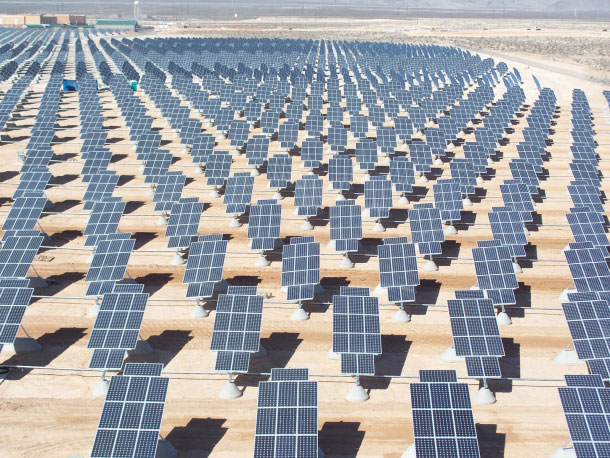
^Tracking photovoltaic array at Nellis Air Force Base in Nevada. Solar Millennium has not yet announced which panel technology and maker it will choose for its Blythe, California project.
August 18, 2011 - In major news, Solar Millennium announced that it will switch the first 500 megawatts of the Blythe Solar Power Project to photovoltaic (PV).
Solar Trust of America, the developer of the world’s largest solar-power plant, will switch technologies to photovoltaic equipment from concentrated solar for the first 500-megawatt phase of the facility near Blythe, California, the company said today in an e-mailed statement. The change was largely motivated by “improved market conditions” for photovoltaic devices, which have plunged in price per kilowatt-hour in recent years, Solar Trust said. China has flooded the workd market with cheap PV panels, lowering the price compared to capital-expensive parabolic trough technology.
Solar Millennium AG and its US subsidiary Solar Trust of America today cited favorable conditions in the PV and commercial lending markets in the United States as the main driver for the decision.
The company may still use Concentrated Solar Power technology for the second 500 MW phase of the project.
“Solar Millennium responds quickly and pragmatically to market conditions, and at the moment the California market favors PV technology,” said Christoph Wolff, CEO of Solar Millennium. “We are taking decisive steps in the US to maximize site value for our company and our shareholders.”
While the company’s first North American project will be converted to PV, Solar Millennium says it maintains a strong international pipeline of CSP projects. “Our long-term strategy remains unchanged. We see solid demand for CSP in the world’s growth markets such as Africa, the Middle East, India and China. This is also true for Southern Europe where we have just achieved financial close on our fourth CSP plant in Spain,” Wolff added.
We note that the green jobs count will go down, however: 500 megawatts of PV requires about 6-8 employees while CSP requires about 60.
Solar Millennium stock dropped 31% following the news. “Blythe was the company’s master project that had protected the stock until today,” Sebastian Zank, an analyst at Sylvia Quandt Research in London, said in a phone interview.“Because of this turnaround, investors are losing trust in Solar Millennium’s business model.”
When called for comment, the Bureau of Land Management told us they will require a supplemental Environmental Impact Statement with a 30 to 60 day review period. There will be no protest period under the Interior Board of Land Appeals.
The California Energy Commission had not yet heard the news as of this morning; they will have to determine whether to continue to oversee the project or drop the license, since they have jurisdiction only over thermal power plants, not photovoltaic, under the Warren-Alquist Act. Solar Trust of America has been arguing this point with their Ridgecrest Solar Power Plant project, asking the CEC to continue to be the lead agency under the California Environmental Quality Act. CEC dropped the license for the re-designed Imperial Valley Solar Project which switched from solar thermal to PV.
Recent Articles
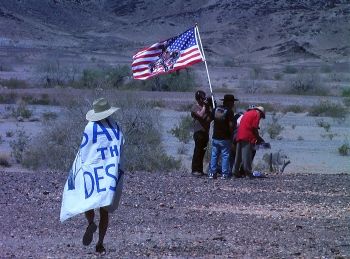
(Photo Copyright 2011 Ruth Nolan)
June 26, 2011 -
Native Group Asks Federal Court to Halt Solar Millennium Blythe Construction
Salem-News.com
Blythe, California - La Cuna de Aztlan Sacred Sites Protection Circle, acting to protect Native American Religious Freedom, filed a renewed application for a temporary restraining order (Case 2:11-cv-04466-JAK -OP) yesterday in United States District Court, Central District of California. According to La Cuna attorney, Cory Briggs, in the Request for TRO" (Temporary Restraining Order), defendant Bureau of Land Management's Right-of-Way Notice to Proceed issued to defendant Palo Verde Solar I, LLC, on November 4, 2010, then subsequently received by the plaintiffs relating to the boundaries of the proposed Blythe Solar project, were in black and white and did not reflect actual boundary lines printed in red on the originals.
Briggs states, "It was not until early May 2011 that my firm received a copy of the Blythe Project's Notice to Proceed--nearly three months after one of my associates had to threaten the pursuit of 'formal legal remedies' in order to get a copy of the Notice to Proceed. The copy that we received was black and white, and thus I was unable to discern the precise lines of the Phase I construction area authorized by the Notice. Until I received a color copy of the Notice to Proceed on June 17, 2011, I had no idea that the lines depicting the boundaries of the Phase I area were actually printed in red."
http://www.salem-news.com/articles/june242011/sacred-site-rl.php

Cory Briggs is also interveiwed in this article at the National Trust for Historic Preservation:
Location, Location, Location: What do many proposed energy projects and priceless historic resources have in common? They occupy the same fragile sites.
By Carlos Harrison, July/August 2011
No one understands the emotional power of place more than Cory J. Briggs, attorney for a group of Native Americans who have sued to block construction of six solar arrays located in the Mojave and near Interstate 10, just west of the California-Arizona border. His clients contend that the six sites contain burial areas and religious artifacts, and form portions of ritual access routes that are as important to the tribes as any temple, church, or mosque. Still, the arrays appear on BLM's list of Approved Renewable Energy Projects.
The day I reached Briggs, he had just returned from visiting the sites. "On one side of the freeway you see a state prison, you see transmission lines, you see truck stops, and you see a bunch of open fields with ruts on them because of motorcycles and dune buggies. But you look across the street, where everything is open and undeveloped and undisturbed and that's where the grading has started? Why not build where nobody cares? What's the difference as far as the government is concerned?"
http://www.preservationnation.org/magazine/2011/july-august/location.html

Riverside County wants a 2 % franchise fee on solar projects, including Blythe Solar Power Project, Palen Solar Power Project, Genesis Solar Energy Project, and Desert Sunlight Solar Farm.
Editorial: A dark day for solar power as tax on plants proposed
MyDesert.com, June 25, 2011


^Alfredo Figueroa of La Cuna de Aztlan Sacred Sites Protection Circle at the Blythe geoglyphs.
From the ZanesvilleTimesRecorder.com:
Green projects enter a gray area: Conservationists criticize plans for huge solar energy plants
June 14, 2011
Plans to create huge solar energy plants in the deserts of California, Arizona, Nevada and elsewhere in the West are pitting one green point of view vs. another. Janine Blaeloch, executive director of the Western Lands Project, a nonprofit group that examines the impacts of government land privatization, supports developing America's renewable energy sources but says fields of mirrors along miles of open desert isn't the way to do it.
"These plants will introduce a huge amount of damage to our public land and habitat," she said.
Protest at Ground-breaking
June 18, 2011 - >>here
Groundbreaking Ceremony to Take Place

^The desert at the project site, with ancient Ironwood trees (Olneya tesota), and natural stony desert pavement.
June 14, 2011 - A groundbreaking for Blythe Solar Power Project will take place in Blythe on Friday June 17, 2011, but will not be on the site. It will be at the Palo Verde Community College at 11:00 a.m. Ken Salazar, the Interior Secretary will be there.
Press Release: Solar Trust of America, LLC - On Monday June 13, 2011, 12:54 pm EDT
Bluthe, Calif.. Solar Trust of America (STA) will break ground on its signature energy project, the Blythe Solar Power Project, the largest solar power facility in the world, on June 17, 2011 at 11:00 AM in Blythe, CA near Palm Springs. upon completion, the facility will deliver 1,000 Megawatts (MW) of generating capacity, or enough electricity to power more than 300,000 homes each year, making it the first solar facility to compare in scale to the largest coal and nuclear power plants.
The Blythe Project received a conditional commitment for a $2.1 billion loan guarantee from the Department of Energy in April. STA worked closely with the Department of the Interior (DOI) and the Bureau of Land Management (BLM) to secure regulatory approval and permits to begin the initial phases of construction on the project last fall.
WHO: Ken Salazar, Secretary, U.S. Department of the Interior; Joseph DeConinck, Mayor of Blythe; Uwe T. Schmidt, Chairman and CEO, Solar Trust of America; Dr. Christoph Wolff, CEO, Solar Millennium AG.
WHAT: Groundbreaking Ceremony for the Worlds Largest Solar Power Plant A WHEN: 11:00 a.m., Friday, June 17, 2011.
WHERE: Palo Verde Community College Auditorium one College Drive Blythe, California.
Complimentary transportation will be provided from the Renaissance Esmeralda Resort and Spa in Indian Wells departing at 9:00 a.m. on Friday, June 17th. Members of the media are invited to join us following the formal program at 11:00 a.m. for a community luncheon and afternoon entertainment program.
Live video of the groundbreaking will be shown at the event site to accommodate media who cannot travel to the event site. B-Roll footage and sound bites of the day's proceedings will also be available after the event. Strong visuals/video of solar thermal technology available, as well.
About Solar Thermal Power Plant Technology:
Solar thermal power plants generate electricity by converting solar radiation into heat energy. In a parabolic trough power plant, trough-shaped mirrors concentrate the solar radiation onto a pipe in the focal line of the collector. Its absorption heats a fluid medium in the pipe, and generates steam in the power block through a heat exchanger. As in conventional power plants, the steam powers a turbine to generate electricity. By integrating thermal storage, electricity can be supplied on demand, even after sunset.
About Solar Trust of America, LLC and Solar Millennium, LLC:
Solar Trust of America, LLC is an integrated industrial solar solutions company strategically positioned to support the critical need for renewable energy generation in the United States. The companya's Project Development, Engineering, Procurement and Construction (EPC), financial resources and operational management expertise ensures the delivery of a fully-integrated concentrated solar power solution using commercially viable and proven parabolic trough solar thermal energy technology. For more information about the company visit SolarTrustOfAmerica.com
See also the website for Blythe Solar Power Project: http://www.blythesolarpower.com/
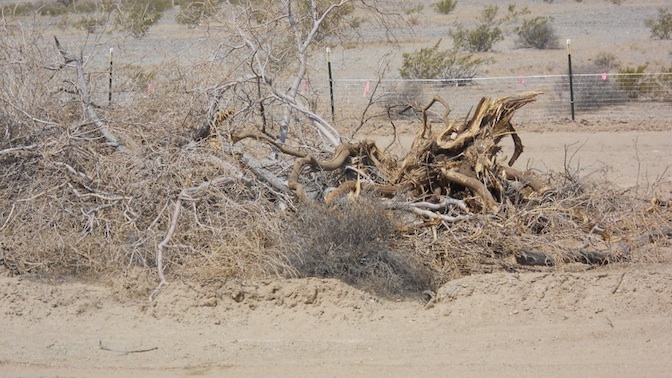
^This is what will happen to the old Desert ironwood trees on the huge solar project site. Construction has already begun, and these trees were bulldozed to make room for Blythe Solar Power Project. A tortoise exclusion fence can be seen along a new road in the background.
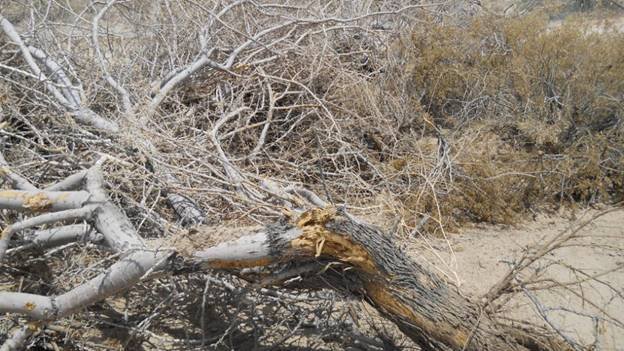
^Wrecked ironwood trees on the project site a few weeks ago.
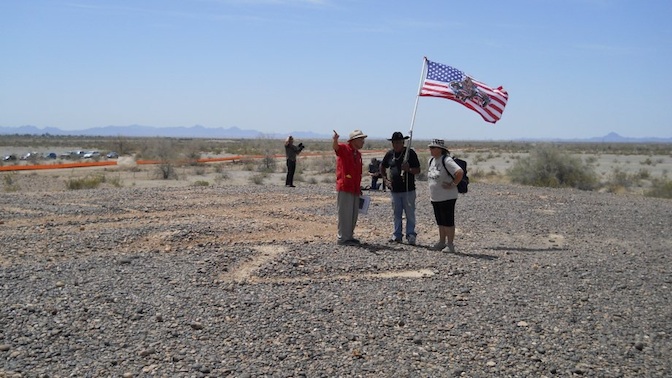
^Protestors stand at a geoglyph cultural site as construction proceeds nearby.
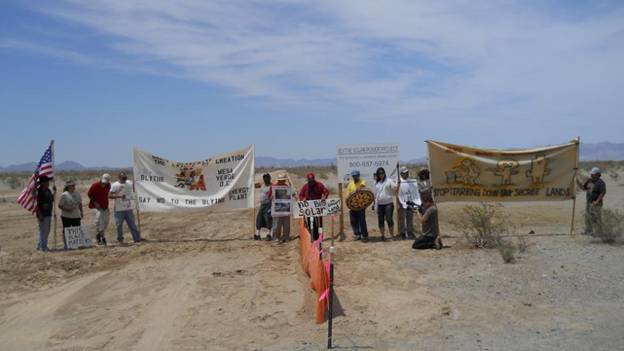
^Protest at a new road that destroyed geoglyphs held sacred to local Native Americans and cultural groups.
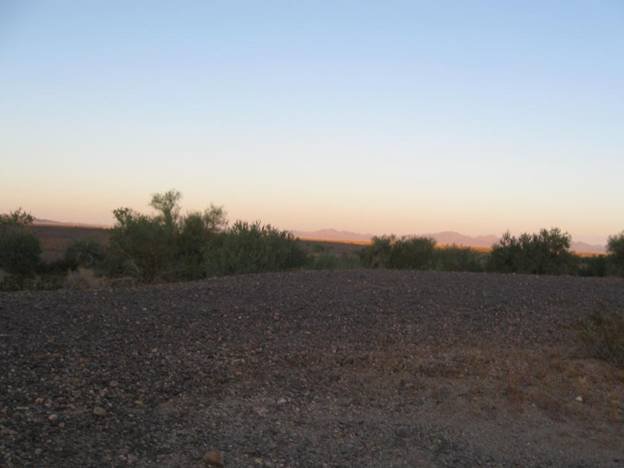
^Quiet sunset on Palo Verde Mesa will be no more.
Robert Lundahl Video Shows Protest of Destruction at Project
No Shame No Respect: Solar Millennium Builds a Road on Ancient Geoglyphs by Robert Lundahl:
May 28, 2011 - Construction, including new roads through culktural sites, has begun on the largest solar project in the US. A new video by Robert Lundahl shows local historian Alfredo Figueroa explaining geoglyphs on the Blythe Solar Power Project site. Unlike the Ivanpah project, this solar plant is parabolic trough and will need to grade 100% of the unique desert pavement on a terrace above the Colorado River. The rounded pebbles of this natural desert pavement are from a Pleistocene (Ice Age) river terrace showing water erosion of the stones. This place is unique, most desert pavement is sharp and angular. The company may put fences around some of the geoglyphs. Desert ironwood trees also grow in washes here and tortoises are present.
DOE Gives Solar Millennium $2.1 Billion Loan Guarantee
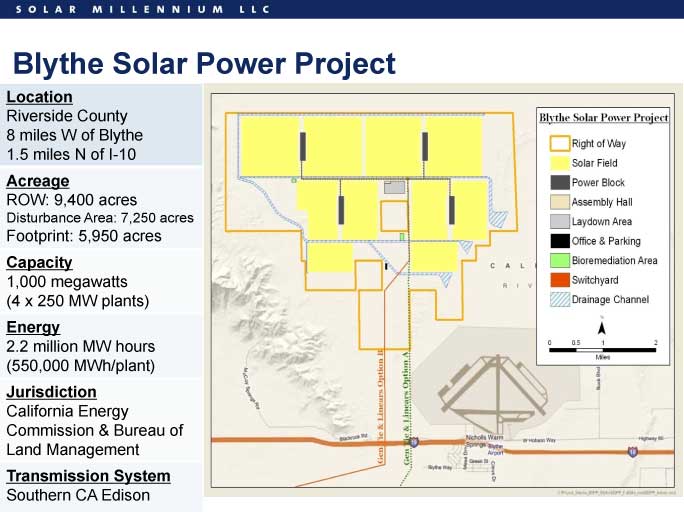
April 18, 2011 - Department of Energy Secretary Steven Chu and California Governor Jerry Brown announced that the first two phases of the Blythe Solar Power Project in Riverside County were awarded a conditional commitment for a $2.1 billion loan guarantee, the largest yet for a solar project.
“We could sit on the sidelines and watch the competition pass us by, or we could get in the race to win,” Chu said.
The Blythe solar thermal facility, by by Solar Trust of America subsidiary Solar Millennium, will initially build 484 megawatts and an eight-mile transmission line. Eventually, the completed project will have a nameplate capacity of 1,000 MW, with a Power Purchase Agreement with Southern California Edison utility.
Native American Group Sues on Blythe and Five Other Solar Projects
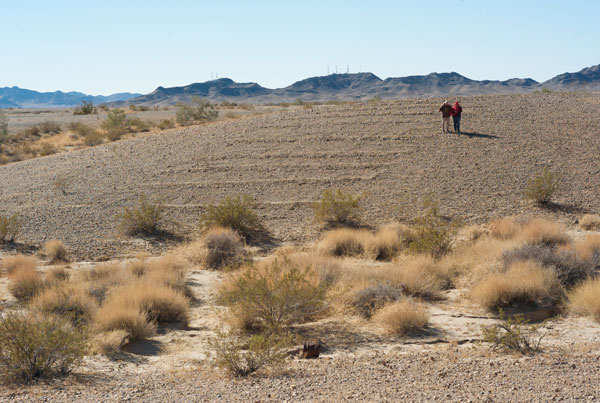
^La Cuna Sacred Sites Protection Circle founder Alfredo Figueroa guides a visitor at "The Temple," a Native American geoglyph outside Blythe, California. According to Figueroa, "The Temple" remains on proposed project lands slated for development by Solar Millenium, LLC, and permitted by the BLM. (Photo by Robert Lundahl).
December 28, 2010 - Six Utility Scale Desert Solar Projects Get Holiday Surprise: Native American group files suit against BLM for failure to consult.
BLYTHE, CA. La Cuna de Aztlan Sacred Sites Protection Circle, a prestigious Native American cultural protection group, filed suit Monday in the United States District Court, Southern District of Caifornia, challenging the Bureau of Land Management permitting processes related to six large solar facilities planned for the Mohave, Sonoran and Colorado deserts of Southern California, Case No.10CV2664 WQH WVG. According to Patricia Pinon, Chairperson of La Cuna's Advisory Committee, the group was joined by CARE, Californians for Renewable Energy, and 6 individual Native American plaintiffs. Pinon indicates La Cuna de Aztlan Sacred Site Protection Circle has standing to sue by virtue of meeting the definition of "Indian Tribe," according to Section 106 of the National Register of Historic Places, and by virtue of an existing Memorandum of Understanding (MOU) with the BLM.
According to court documents, the projects include the Ivanpah Solar Electric Generating Project (Brightsource Energy), the Blythe Solar Power Project (Chevron Energy Solutions and Solar Millenium, LLC), the Imperial Valley Solar Project (Tessera/NTR), Chevron Energy Solutions Lucerne Valley Solar Project, Calico Solar Project (Tessera/NTR), and the Genesis Project (Florida Power and Light subsidiary NextEra™). La Cuna founder Alfredo Figueroa states that cumulatively, the projects would grade and develop 23,842 acres of essentially pristine desert lands, designated as class "L" under the California Desert Conservation Area Plan. Class L (Limited Use) lands protect "natural, scenic, ecological, and cultural resource values.The lands are "managed to provide for generally lower-intensity, carefully controlled multiple use of resources, while ensuring that sensitive values are not significantly diminished." The complaint indicates that each of the projects was permitted with an "amendment" to the CDCA according to the Bureau of Land Management.
The suit follows the filing of the Quechan tribe's legal challenge to the imperial Valley Solar Project which was granted an injunction by Judge Larry Burns on December 15, Civil Action No. '10CV2241 LAB CAB, United State District Court for the Southern District of California. Robert Lukefahr, CEO of Tessara Solar said at the time, "Tessera Solar is deeply disappointed with the federal court's ruling last night." Company press releases stated on December 9, 2010 (prior to Congress extending the time limits for ARRA, American Reinvestment and Recovery Act 30% project cash grants--at the end of the lame duck session--to December 30, 2011) parent company NTR (National Toll Roads of Ireland) had taken a "write down" of 96 million Euros. The Quechan suit further clouds the issues for investors. Now La Cuna de Aztlan's complaint and request for a Temporary Restraining Order (TRO), giving time for an injunction to be considered by the court, adds another impediment for industrial development of the desert. Following LaCuna's fiing, the future of 5 additional projects is in jeopardy.
According to la Cuna de Azlan's Pinon, the pressure of the ARRA "fast track" process approved by Secretary of the Interior Ken Salazar resulted in inadequate Environmental Impact Statements and inadequate government to government consultation with the tribes, under Section 106 of the National Register of Historic Places. Bill Powers of San Diego based Powers Engineering, a prominent energy engineer states, "So the Orwellian aspect of the government involvement in this process is that now instead of the analysis being focused on is this a cost effective project, is it a project that will minimalize or eliminate environmental damage, is it a good investment strategically for this state, all of that is secondary for the race to get the permit so that the project can get a 30 percent cash grant. In this case -- that's $600 million up front per project. So the money is so big that it's now like a bull rush to the finish line."
The potential impacts are both environmental and cultural. Jim Andre, Ph.D. University of California Riverside botanist, and Director of the Sweeney Granite Mountains Desert Research Institute states, “Rather than be smart from the start by utilizing ecologically degraded sites first, a reckless and scientifically unmerited decision has been made to instead race into our most pristine desert and obliterate some of the most botanically significant lands in California.” With over 250 projects in application in California alone, over 2 million acres of desert would be graded if all of the projects now in application were to be approved. Dr. Andre continues, "This scale of an impact has never occurred before. When you consider the importance of these (eco) systems to provide corridors for species to move as climate changes, whether its human caused change, or just the natural course of variation in climate change, you’ve really done in the entire ecosystem at that scale."
At stake also are the region's unique and invaluable cultural resources. According to the testimony of Elizabeth A. Bagwell, Ph.D., RPA and Beverly E. Bastian before the California Energy Commission, " This analysis estimates that more than 800 sites (Cultural Resource Sites--Sacred Sites) within the I-10 corridor, and 17,000 sites within the Southern California Region will be potentially destroyed. La Cuna de Aztlan Sacred Sites Protection Circle has an agreement with the BLM to work together to protect Native American sacred sites and cultural resources.
The group did not add Palen Solar Power Project (Solar Millennium) or First Solar's Desert Sunlight Solar Farm to the suit because BLM has not yet issued a Right-of-Way for these yet. These projects do, however, negatively impact cultural resources as well.

^Airborne dust from grading private land outside Blythe, California rises from the desert floor. "Desert pavement" normally caps the soils here. It is formed by the gradual removal of sand, dust and other fine grained material by the wind and intermittent rain. Once the pavement has been formed it can act as a barrier to further erosion (Wikipedia). When grading takes place, the desert pavement is scraped away, leaving powdery soils which become airborne, affecting air quality. Blythe Solar is a project of Solar Millenium LLC and Chevron Energy Solutions. The companies have proposed to grade 9500 acres at the site. According to the companies, Blythe Solar would be he largest utility scale central-station solar facility in the U.S. (Photo by Robert Lundahl).
http://www.sbsun.com/news/ci_16962181
http://www.signonsandiego.com/news/2010/dec/28/indian-activists-lawsuit-block-big-solar-farms/
Blythe Spirit Run a Success
October 30, 2010 - >>here
Salazar Approves Blythe Solar Power Project
^Artist's representation of the massive solar thermal power plant.
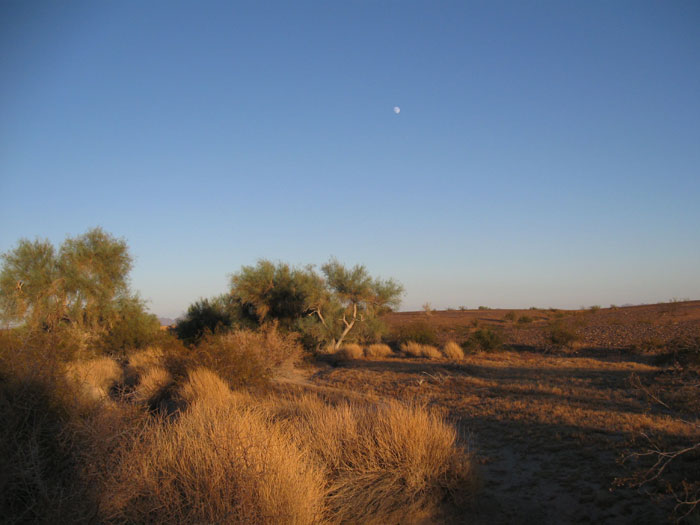
October 25, 2010 - Blythe Solar Power Project signed by Interior Secretary Salazar: 1,000 megawatt parabolic trough solar thermal plant on 7,025 acres of public land, with Ironwood trees, Palo verde, Galleta grass, and numerous cultural sites, will be scraped 100% bare, at a cost of $6 Billion. Not disturbed, but Colorado Desert rich in microphyll woodland, with Palo Verdes, Smoke trees, and Desert ironwood.
Join the Run to Protect Sacred Sites!
October 20, 2010 - Blyhte, California - AMERICAN INDIAN RUNNERS TO FOLLOW ANCIENT TRAILS IN A SPIRITUAL JOURNEY IN THE COLORADO DESERT
The Trails Link Sacred Sites and Cultural Resources Threatened by Desert Solar Power Construction.
The Blythe Giant Intaglios have a story to tell. According to Chemehuevi Tribal Monitor and elder historian, Alfredo Acosta Figueroa, “the giant 200-foot long figures on the desert floor outside Blythe, California, represent Woman, Man and the Creator in the Uto-Aztecan cosmological view.”
On Saturday, October 30, 2010, beginning with a Sunrise Ceremony, a sacred spiritual journey/trek will commence at the Blythe Giant Intaglios (15 miles north of Blythe on Highway 95) and proceed through 10 endangered sacred sites. It will be concluded by a “New Fire Ceremony”, featuring Aztec dancers from Danza Cuauhtémoc, to be held at dusk, (7-miles west of Blythe off I-10 on Mesa Verde Drive; south). A press conference will take place at the Midland Visitors Center, (9 miles North of Blythe on north Lovekin Blvd at noon). Refreshments and light snacks will be served.
The Sacred Intaglios are not alone. Filmmakers Robert Lundahl and Robert Gonzales Vasquez have documented scores of geoglyphs in the nearby desert, and local historians indicate the presence of hundreds of figures along the Colorado River extending from Needles, California to Yuma, Arizona and centered in Blythe, California.
But when the German solar energy company Solar Millennium, with the help of Chevron, applied for a permit to build an industrial solar facility on BLM lands, the features, which can best be seen from the air, were overlooked. Project lands for the Blythe Solar construction on 7500 acres contain world-wide well known geoglyphs including Kokopilli, Cicimitl, El Tosco, the 16 layer Temple, and other features. Flaked quartz left as offerings over hundreds of years by native peoples indicate the cultural importance of the sites to be destroyed if the Blythe Solar power project is built as planned.
The California Energy Commission approved the project application citing “overriding concerns,” referring to the State’s mandate to implement renewable energy sources under the 33% Renewable Energy Portfolio Standard (by 2020) and the BLM similarly approved the construction, disputing the age of certain features and ignoring others.
La Cuna de Aztlán Sacred Sites Protection Circle is hosting the event to draw public attention to these unique, historical and cultural features some say are related to Aztec culture and to promote solar energy done right, on already distressed lands and rooftops. The event is also sponsored by the Californians for Renewable Energy (CARE), Inland Mexican Heritage, Mojave Spiritual Runners, Ward Valley Warrior Veterans, Peace & Dignity Journey Staff Guardians, Danza Cuauhtémoc, La Escuela de la Raza Unida and many others.
An aerial video of sacred sites may be seen at Freshwater Bay Pictures/Advocacy Films website,
La Cuna de Aztlán Sacred Sites Protection Circle
Alfredo Acosta Figueroa, Coordinator/Elder Historian & Chemehuevi Tribal Monitor
424 North Carlton Ave.
Blythe, Ca 92225
Phone: (760) 922-6422. Email: lacunadeaztlan@aol.com
Freshwater Bay Pictures, LLC
Robert Lundahl, Principal
833 So. Cedros Ave. #50
Solana Beach, CA 92075
Phone: (415) 205-3481. Email: robert@studio-rla.com
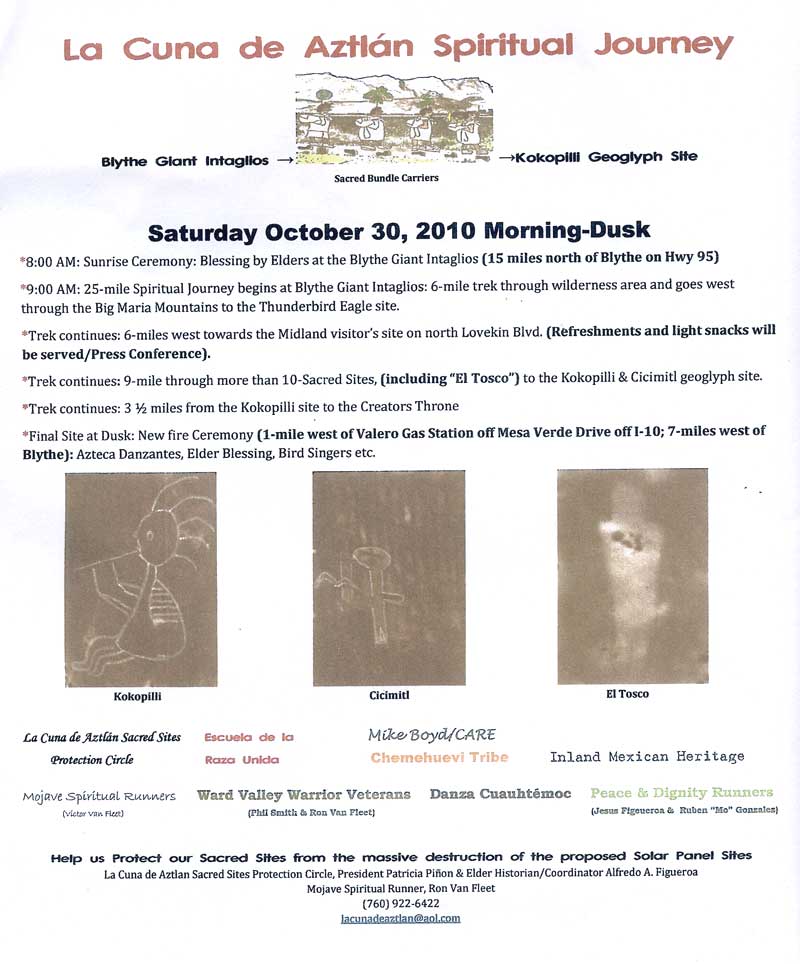
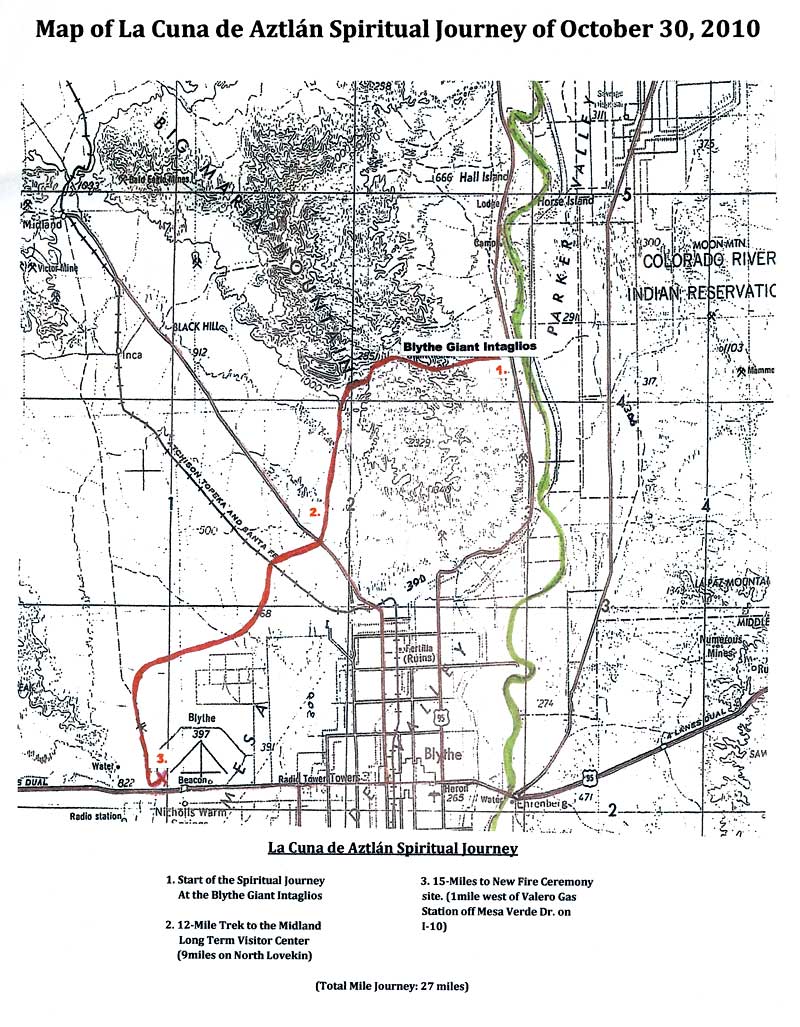
Help Save the Geoglyphs
October 8, 2010 - We need your support to protect Kokopilli!
Please sign our petition to protect and preserve the Blythe geoglyphs endangered by construction of a proposed solar power project.
You can sign here:
http://www.petitiononline.com/savekoko/petition.html
Spiritual Run October 30, 2010
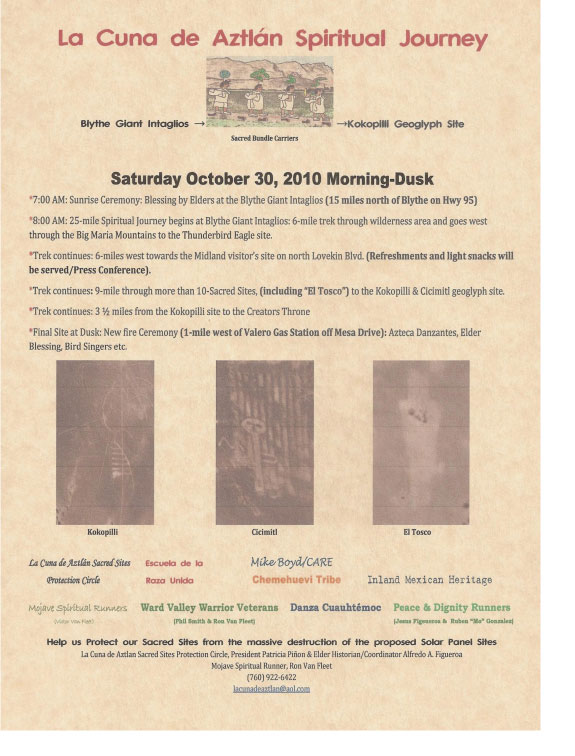

Concern Over Weeds
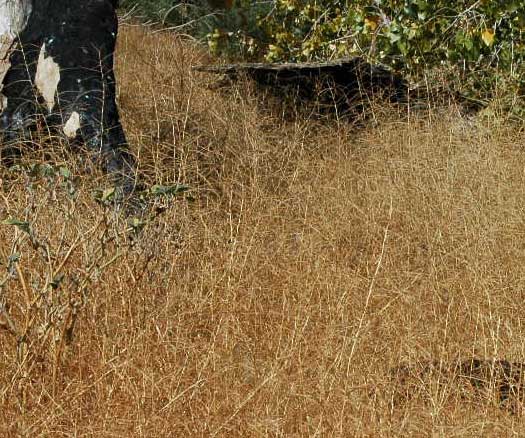
^Dried Sahara mustard choking the ground by cottonwoods in Big Morongo Canyon Preserve.
September 29, 2010 - At a California Energy Commission workshop for the Palen Solar Power Project on September 27, CEC botanist Carolyn Chaney Davis told Solar Millennium there was a big concern over weeds taking over newly disturbed desert ground at both the Blythe Solar Power Project and at Palen. Chaney Davis had spent much time out in the field at the Blythe project site with preeminent tortoise biologist and desert ecologist Dr. Kristin Berry, who worried over the spread of the rampaging weed Sahara mustard (Brassica tournefortii).
The big concern at Blythe was the spread of weeds along the new "linears," the transmission lines needed to tie the giant solar thermal project to the grid. Berry was emphatic that Sahara mustard spread must be taken much more seriously. Transmission lines act as superhighways for its expansion into desert habitat.
Chaney Davis explained that revegetation after disturbance, such as when the power plant is decommissioned in 30 years, does not usually work in this arid region. So she stressed weed management from the start. Instead of imprinting or planting creosote, the desert should be restored by preserving the topsoil and seedbank. Disrupting biotic soil crusts allows weeds to gain a foothold and increase.
The companies need to manage outbreaks of weeds that happen after initial soil disturbance. A revegetation plan would also include mulching temporary roads after use so the off-roaders do not use them, further spreading weed seeds on tires. The Energy Commission was worried about spread of Sahara mustard into the tortoise Critical Habitat in Chuckwalla Desert Wildlife Management Area. The weeds can grow so densely that the reptiles cannot move through them, and the mustards displace more palatable native wildflowers.
California Department of Fish and Game recommends a 10-year monitoring period to make sure revegetation is progressing. A 2 or 3 year period is not long enough, as only pioneer plants would be colonizing the disturbed ground. A trend towards climax vegetation would longer to see.
Energy Commission Licenses Blythe
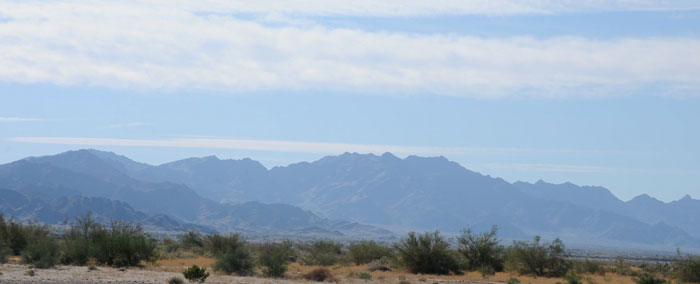
^McCoy Mountains from Palo Verde Mesa.
September 15, 2010 - Energy Commission Licenses 1,000 MW Solar Power Plant:
Blythe Project Would Be Largest Concentrated Solar Power Plant in the World
SACRAMENTO - In a move to increase renewable energy in California, the California Energy Commission today approved the construction of the 1,000-megawatt Blythe Solar Power Project. The plant would be the world's largest concentrated solar power facility. Additionally, the project would be among the first commercial solar thermal power plants permitted on federal public land in the United States. (The largest solar thermal plant today is the 80 MW SEGS VIII and IX at Harper Dry Lake.)
In a unanimous vote, the Energy Commission adopted the presiding member's proposed decision (PMPD) that recommended licensing the facility proposed for eastern Riverside County.
"We are excited to add 1,000 megawatts of clean, renewable energy that will provide Californians with green jobs while advancing the State's renewable energy and climate goals," said Energy Commission Chairman Karen Douglas, who served as the presiding member of the committee that reviewed the plant's application for certification. "The success in licensing the Blythe project is due to the strong collaboration with the Bureau of Land Management, the Department of the Interior, and the U.S. Fish and Wildlife
Service. This is a significant step forward for California."
The project is the first solar thermal power plant on federal land to be voted upon by the Commission. The BLM, which approves the use of U.S. public lands, is scheduled to make a decision before the end of October. The BLM ruling is the final step before the project can proceed.
The eight other high priority projects are: the 250-MW Abengoa Mojave Solar Project; the 250-MW Beacon Solar Energy Project; the 850-MW Calico Solar Project; the 250-MW Genesis Solar Energy Project; the 709-MW Imperial Valley Solar Project; the 370-MW Ivanpah Solar Electric Generating System Project; the 500-MW Palen Solar Power Project; and the 150-MW Rice Solar Energy Project.
The Blythe Solar Power Project is the third project that the Commission has approved in three weeks. The Beacon Solar Energy Project, the first solar thermal power plant permitted in 20 years, was licensed Aug. 25 and the Abengoa Mojave Solar Project on Sept. 8.
The PMPD for the Blythe Solar Power Project said the facility, even with mitigation measures, will have significant impacts on cultural resources, land use, traffic and transportation, and visual resources. The project will also be inconsistent with a land use provision in the Riverside County Land Use Plan. However, the benefits of the project would justify a legal override of those impacts. In addition, the committee determined the project complies with all other applicable laws, ordinances, regulations, and standards.
The Blythe Solar Power Project is being developed by Solar Millennium, LLC, a subsidiary of Solar Trust of America. The project site is located in an unincorporated area of Riverside County, approximately two miles north of U.S. Interstate 10 and eight miles west of Blythe. The applicants have applied for a right-of-way authorization from the BLM for 9,400 acres, with 7,025 acres for construction and operation.
The proposed project would use parabolic trough technology where parabolic mirrors are used to heat a transfer fluid which is then used to generate steam. Electricity is produced from the steam expanding through steam turbine generators. The project's proposed 1,000-MW output will be generated by four independent 250-MW units.
The proposed solar thermal power projects that the Energy Commission is considering will help meet the state's Renewables Portfolio Standard, which requires California's electricity utility companies to use renewable energy to produce 20 percent of their power by 2010 and 33 percent by 2020. Solar energy is a main source of renewable power.
The federal government and the State of California have established the need to increase the development and use of renewable energy in order to enhance the nation's energy independence, meet environmental goals, and create new economic growth opportunities.
From CEC News Release.
Governor Arnold Schwarzenegger: “I applaud the California Energy Commission’s decision to approve the construction of the Blythe Solar Power Project - the world’s largest – and am excited to see other solar projects move forward. Projects like this need our immediate attention, as solar and renewable power are the future of the California economy.”
The project will cost $4 billion total, $1 billion per plant, 250 MW each. The power purchase agreements between Solar Millennium LLC, Oakland, and the energy provider Southern California Edison (SCE) for the first two 250-MW solar power plants initially scheduled to be built were approved by the California Public Utilities Commission (CPUC) in July.
The company notes that it is also actively pursuing completion of financing with the U.S. Department of Energy loan-guarantee program for the first phase of the project, which represents approximately 500 MW of generating capacity.
We talked with local Tribes, the Mohave and Chemehuevi, who are strongly against this project for ignoring the hundreds of cultural sites that will be destroyed. They feel BLM is ignoring them, and that this project is in the wrong place on Palo Verde Mesa with desert pavement that holds geoglyphs.
Unique Desert Habitats
Augist 25, 2010 - The below quote comes from the Environmental Impact Statement for the Blythe Solar Power Plant in the Affected Environment section. This does not even touch the cultural issues.
"The site is located within the within the Palo Verde Mesa of the Sonoran Desert region of southeastern California, an alluvial-filled basin that is bounded by the Mojave Desert to the north and by the McCoy Mountains, Little Maria Mountains, and Big Maria Mountains to the west, northwest, and northeast, respectively, extending southwest to the Palo Verde Mountains. The Palo Verde Mesa is bounded by the Palo Verde Valley to the east, which is generally formed by flood plain deposits of the Colorado River. The unique position of the region at the junction with the Neotropic ecozone to the south contributes to the presence of a number of rare and endemic plants and vegetation communities specially adapted to this bi-modal rainfall pattern, and not found elsewhere in California. These include microphyll woodlands, palm oases, and a number of summer annuals that only germinate after a significant warm summer rain. Although the region supports numerous perennial species, including a wide variety of cacti, more than half of the region's plant species are herbaceous annuals, which reveal themselves only during years of suitable precipitation and temperature conditions."
http://www.blm.gov/ca/st/en/fo/palmsprings/Solar_Projects/Blythe_Solar_Power_Project.html
BLM Releases Final Environmental Impact Statement
August 20, 2010 - Notice of Availability of the Final Environmental Impact Statement for the Chevron Energy Solutions/Solar Millennium Blythe Solar Power Plant and Proposed California Desert Conservation Area Plan Amendment was announced today by the Bureau of Land Management.
SUMMARY: In accordance with the National Environmental Policy Act of 1969, as amended (NEPA), and the Federal Land Policy and Management Act of 1976, as amended (FLPMA), the Bureau of Land Management (BLM) has prepared a Proposed California Desert Conservation Area (CDCA) Plan Amendment/Final Environmental Impact Statement (EIS) for the Chevron Energy Solutions/Solar Millennium (CESSM), LLC's Blythe Solar Power
Plant (BSPP) project and by this notice is announcing its availability.
DATES: The publication of the Environmental Protection Agency's (EPA) Notice of Availability (NOA) of this Final EIS in the Federal Register initiates a 30-day public comment period. In addition, the BLM's planning regulations state that any person who meets the conditions described in the regulations may protest the BLM's Proposed CDCA Plan Amendment/Final EIS. A person who meets the conditions and files a protest must file the protest within 30 days of the date that EPA publishes its NOA in the Federal Register. The protest procedures are described in the "Dear Reader'' letter accompanying the Proposed Plan Amendment/Final EIS.
ADDRESSES: Copies of the Proposed CDCA Plan Amendment/Final EIS for the BSPP Project have been sent to affected Federal, state, and local government agencies and to other stakeholders. Copies are available for public inspection at the Palm Springs South Coast Field Office, 1201 Bird Center Drive, Palm Springs, California 92262. Interested persons may also review the Proposed CDCA Plan Amendment/Final EIS at the
following Web site:
http://www.blm.gov/ca/st/en/fo/palmsprings/Solar_Projects/Blythe_Solar_Power_Project.html
Submit comments on the Final EIS to Allison Shaffer, BLM Project Manager, Palm Springs South Coast Field Office, 1201 Bird Center Drive, Palm Springs, California 92262; or e-mail: CAPSSolarBlythe@blm.gov. All protests must be in writing and mailed to one of the following addresses: Regular Mail: BLM Director (210), Attention: Brenda Williams, P.O. Box 66538, Washington, DC 20035.
Overnight Mail: BLM Director (210), Attention: Brenda Williams, 1620 L Street, NW., Suite 1075, Washington, DC 20036.
FOR FURTHER INFORMATION CONTACT: Allison Shaffer, BLM Project Manager,
telephone (760) 833-7100; address (see ADDRESSES above).
SUPPLEMENTARY INFORMATION: CESSM has submitted a right of way (ROW) application to the BLM for development of the proposed BSPP project, consisting of 4 parabolic trough solar thermal power plants. The project would be built in 4 phases which are designed to generate approximately 968 megawatts (MW) of electricity at full development. The project footprint is approximately 5,950 acres of BLM-managed lands, with a proposed ROW encompassing 9,400 acres. The project site is in Riverside County, California, approximately 8 miles west of Blythe, California, 3 miles north of Highway I[hyphen]10, and 1 mile north of the Blythe Regional Airport. The project includes the power generation facility, an electrical transmission line, natural gas pipeline, and an access road. A double
circuit 230-kilovolt (kV) transmission line would be constructed to interconnect to the Devers-Palo Verde 2 500 kV line at the Colorado River substation. Approximately 6.5 miles of this new line would be outside the project area but is included in the analysis. The new line proposes to use a 175-foot wide ROW. The BLM's purpose and need for the NEPA analysis of the BSPP project is to respond to CESSM's application under Title V of FLPMA (43 U.S.C. 1761) for a ROW grant to construct, operate, and decommission a solar thermal electric generation facility on public lands in compliance with FLPMA, BLM ROW regulations, and other applicable Federal laws. The BLM will decide whether to approve,
approve with modification, or deny a ROW grant to CESSM for the proposed BSPP project. The BLM will also consider amending the CDCA Plan in this analysis. The CDCA Plan (1980, as amended), while recognizing the potential compatibility of solar electric generation
facilities on public lands, requires that all sites associated with power generation or transmission not identified in the CDCA Plan be considered through the plan amendment process. If the BLM decides to grant a ROW, the BLM would also amend the CDCA Plan as required.
In the Final EIS, the BLM's proposed action is to authorize the BSPP project and approve a CDCA Plan amendment in response to the application received from CESSM. The BLM's preferred alternative is the proposed action. In addition to the proposed action, the BLM is
analyzing the following action alternatives: (1) authorize a reconfigured 1,000-MW alternative and amend the CDCA Plan; and (2) authorize a smaller 750-MW alternative and amend the CDCA Plan. As required under NEPA, the Final EIS analyzes a no action
alternative that would not require a CDCA Plan Amendment. Additionally, the Final EIS analyzes two additional no action alternatives: (1) A no action alternative which would deny the project but amend the CDCA Plan to allow other solar energy power generation projects on the project site and (2) a no action alternative which would deny the project and amend the CDCA Plan to prohibit solar energy projects on the project site. The BLM will take into consideration the provisions of the Energy Policy Act of 2005 and Secretarial Orders 3283 Enhancing Renewable Energy Development on the Public Lands and 3285A1 Renewable Energy Development by the Department of the Interior in responding to the BSPP application.
The Final EIS evaluates the potential impacts of the project on air quality, biological resources, cultural resources, water resources, geological resources and hazards, land use, noise, paleontological resources, public health, socioeconomics, soils, traffic and
transportation, visual resources, wilderness characteristics, and other resources.
The Applicant has applied to the Department of Energy (DOE) for a loan guarantee under Title XVII of the Energy Policy Act of 2005 (EPAct 05), as amended by Section 406 of the American Recovery and Reinvestment Act of 2009, Public Law 111-5 (the "Recovery Act''). The DOE has entered into negotiations of a loan guarantee with the applicant, and is a cooperating agency in developing the Final EIS. An NOA for the BSPP Draft EIS/Draft CDCA Plan Amendment and California Energy Commission Staff Assessment (SA) was published by EPA in the Federal Register on March 19, 2010 (75 FR 13301). The formal 90-day comment period ended on June 16, 2010. Comments on the Draft EIS/plan amendment received from the public and internal BLM review were considered and incorporated as appropriate into the proposed plan amendment. Public comments resulted in the addition of clarifying text, but did not significantly change proposed decisions.
Instructions for filing a protest with the Director of the BLM regarding the BSPP Project may be found in the BSPP Proposed CDCA Plan Amendment/Final EIS "Dear Reader'' letter and at 43 CFR 1610.5-2. E-mailed or faxed protests will not be accepted as valid protests unless the protesting party also provides the original letter by either regular or overnight mail postmarked by the close of the protest period. Under these conditions, the BLM will consider the e-mailed or faxed protest as an advance copy and it will receive full
consideration. If you wish to provide the BLM with such advance notification, please direct faxed protests to the attention of the BLM protest coordinator at (202) 912-7212, and e-mails to Brenda_Hudgens-Williams@blm.gov. All protests, including the follow-up letter to e-mails or faxes, must be in writing and mailed to the appropriate address, as set forth in the ADDRESSES section above. Before including your phone number, e-mail address, or other personal identifying information in your protest, you should be aware that your entire protest--including your personal identifying information--may be made publicly available at any time. While you can ask us in your protest to withhold your personal identifying information from public review, we cannot guarantee that we will be able to do so.
Blythe Preliminary Approval by Energy Commission
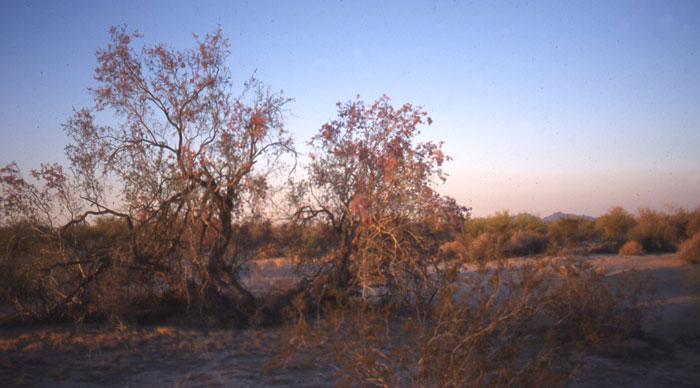
^Desert ironwood (Olneya tesota) woodlands line washes through the proposed solar development site, harboring many bird species. These will be bulldozed.
August 11, 2010 - The California Energy Commission released its Proposed Decision, recommending the license for the Blythe Solar Power Project.
In its presiding member's proposed decision (PMPD) released today, the committee said the proposed 1,000-megawatt facility, as mitigated, will have no significant impacts and complies with applicable laws, ordinances, regulations, and standards (LORS) in most environmentalareas. The committee also determined that the project's benefits outweigh its environmental impacts and recommends that the Commissionmake override findings and approve the project in spite of the impacts.
The PMPD is not a final decision on the project. The committee released the document for 30 days of public comment and will consider input before bringing the proposed decision to the full five-member Commission. The entire document can be found on the Commission's website at: http://www.energy.ca.gov/sitingcases/solar_millennium_blythe/documents/
The Blythe Solar Power Project is being jointly developed by Solar Millennium, LLC, and Chevron Energy Solutions. The project site islocated in an unincorporated area of Riverside County, California, approximately two miles north of U.S. Interstate 10 and eight miles west of Blythe. The applicants have applied for a right-of-way grant from the
U.S. Bureau of Land Management. If approved, the plant would use solar parabolic trough technology by collecting heat energy from the sun and using heat transfer fluid to generate steam in a boiler that will power turbine generators to produce electricity. The project's proposed 1,000-megawatt output will be generated by four identical and
independent 250-megawatt units.
The Energy Commission says: "The federal government and the State of California have established the need for the nation and state to increase the development and use of
renewable energy in order to enhance the nation's energy independence, meet environmental goals, and create new economic growth opportunities.
For more information on Gov. Arnold Schwarzenegger's Executive Order to advance the state's Renewables Portfolio Standard, go to: http://gov.ca.gov/press-release/13273
More information on the Blythe Solar Power Project is available at:
http://www.energy.ca.gov/sitingcases/solar_millennium_blythe/index.html
The 30-day public comment period on the PMPD ends on September 10, 2010. Members of the public and governmental agency representatives are encouraged to submit their written comments by the close of the 30-day review period. The Energy Commission encourages comments by e-mail. Please include your name or organization’s name in the name of the file. Those submitting attached comments by electronic mail should provide them in either Microsoft Word format or as a Portable Document (.pdf) to [docket@energy.state.ca.us]. One paper copy must also be sent to the Energy Commission’s Docket Unit, 1516 Ninth Street, MS-4, Sacramento, CA 95814. Identify all comments with “Docket No. 09-AFC-6.”
The Committee will hold a Committee Conference on the PMPD to vote and make the final decision:
TUESDAY, AUGUST 31, 2010
Beginning at 2:00 p.m. (Why is this decision before the end of the public comment period?)
Public comments are accepted by telephone (for instructions see http://www.energy.ca.gov/calendar/events/index.php?com=detail&eID=1113).
Cultural Issues Addressed in Video
July 29, 2010 - La Cuna de Aztlán (With Updated Comments By Chemehuevi Tribal Chairman, Charles Wood), video by Robert Lundahl. http://www.vimeo.com/13650564
McCoy Wash Tortoise Survey in Year 2000
Near Blythe, Historian Sees Solar Plants as Threat to Desert Carvings
April 24, 2010 - Alfredo Figueroa has made it his mission to guard huge carvings known as
geoglyphs. His biggest concern was damage from off-roaders. Now he worries
that solar energy plants could do even more.
See Los Angeles Times.
Flier distributed by La Cuna de Aztlan Sacred Sites Protection Circle:
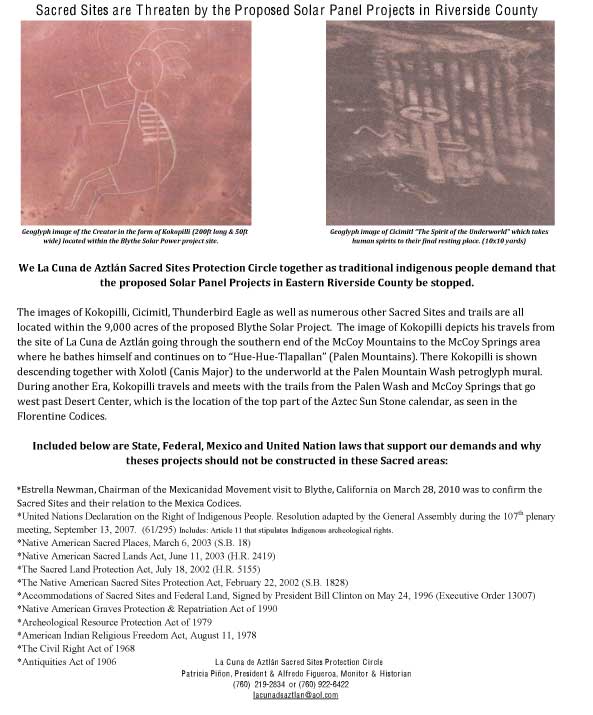
Chevron Energy Solutions/Solar Millennium Blythe Solar Power Plant
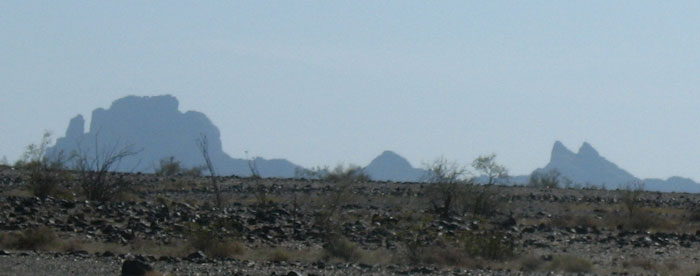
This site is eight miles west of Blythe, California, and three miles north of Interstate 10. The proposed Blythe Solar Power Project would consist of four parabolic trough solar thermal power plants similar to the Palen project. The four power plants would generate approximately 968 MW of electricity. All four plants would share administrative buildings,
parking areas, maintenance buildings, switch yards, bioremediation areas, wastewater treatment facilities, access and maintenance roads, and perimeter fencing. The project would also include a natural gas pipeline, communication lines, and a 500 kV transmission line. The total expected project footprint would be approximately 6,300 acres. During construction, the project would require approximately 3,100 acre feet of water for dust control and soil compaction. During operation, the project would require approximately 600 acre-feet of water per year. CESSM proposes to use water from new wells. It would be constructed in four phases.
COMMENTS on both the Palen and Blythe projects may be submitted in writing until December 23, 2009. Send to: http://www.blm.gov/ca/st/en/fo/palmsprings.html.
E-mail: asolomon@energy.state.ca.us, CAPSSolarPalen@blm.gov, or CAPSSolarBlythe@blm.gov.
Fax: (760) 833-7199.
Mail: Alan Solomon, Project Manager, Siting, Transmission and Environmental Protection Division, CEC, 1516 Ninth Street, MS-15, Sacramento, California 95814 or Holly L. Roberts, Project Manager, Palm Springs-South Coast Field Office, BLM, 1201 Bird
Center Drive, Palm Springs, California 92262.
[Federal Register: November 23, 2009 (Volume 74, Number 224), Page 61169-61171, wais.access.gpo.gov]
See:
http://www.energy.ca.gov/sitingcases/solar_millennium_blythe/index.html
HOME.....September Site Visit.....Chuckwalla Valley.....Solar Millennium Palen
